




Gwangju & South Jeolla International Magazine






Gwangju & South Jeolla International Magazine

June 2025, Issue 280
Published: June 1, 2025
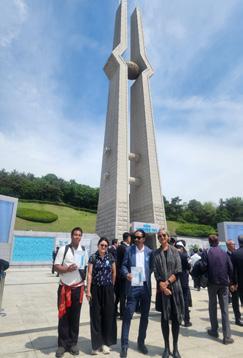
Cover Photo
Gwangju Prize for Human Rights Awardees at the May 18 National Ceremony
Photo courtesy of The May 18 Foundation
Publisher Dr. Shin Gyonggu
Editor-in-Chief Dr. David E. Shaffer
Copy Editing Dr. David E. Shaffer
Layout Editor Johanna Lezada
Online Editor Johanna Lezada
The Gwangju News is the first English monthly magazine for the general public in Korea, first published in 2001. Each monthly issue covers local and regional issues, with a focus on the roles and activities of the international residents and local English-speaking communities.
Copyright ©2025 by the Gwangju International Center. All rights reserved. No part of this publication covered by this copyright may be reproduced in any form or by any means –graphic, electronic, mechanical, photocopying, recording, or otherwise – without the written consent of the publisher.
The Gwangju News is published by the Gwangju International Center: Jungang-ro 196-beon-gil 5 (Geumnam-ro 3-ga), Dong-gu, Gwangju 61475, South Korea
Tel: (+82)-62-226-2733
Fax: (+82)-62-226-2731
Website: www.gwangjunewsgic.com
Email: gwangjunews@gic.or.kr
Registration No. 광주광역시 라. 00145 (ISSN 2093-5315)
Registration Date: February 22, 2010
For volunteering and article submission inquiries, please contact the editor at gwangjunews@gic.or.kr
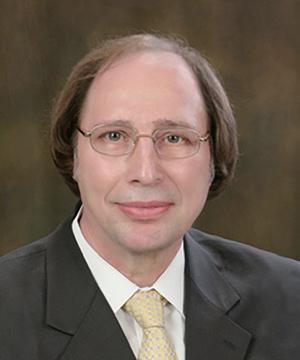
June is in the air, inviting all to begin thinking about summer vacation plans and pet projects that have been in waiting. Here at the Gwangju News, however, the staff hasn't had much time to consider rest and relaxation with the previous month being an especially “event-full” period for the city of the Spirit of May.
Our cover feature this issue concerns the Gwangju Prize for Human Rights, awarded each May to a group or individual with outstanding efforts in this field. This year’s award went to AJAR, an Indonesiabased NGO. We bring you an interview with its co-founder Patrick Burgess.
Our second feature is an article by John Feffer, who recently spoke on Gwangju stepping up to fill the human rights vacuum at the Gwangju Democracy Forum sponsored by the May 18 Foundation.
What happened in June thirty-eight years ago? The 1987 June Democratic Struggle. Our third feature describes this uprising, how it was pivotal in bringing genuine democracy to South Korea, and how it was the inspiration of the May 18 Gwangju Uprising that allowed it to occur.
Moving on to more tranquil topics, we offer a soulful journey to Daeheung Temple in Haenam County’s Duryun Mountain and suggest bike rentals for weekend outings. We also provide one expat’s “journey” through Korea’s healthcare system, as well as another expat’s “journey” from quiet seat-warmer to confident speaker as president of Toastmasters.
Learn of the challenges facing international undergraduate students in our article on “Breaking Cultural Barriers.” Learn how fragrance is polluting our planet in our Environment column for this issue. And learn about the celebrated temples in the Jeonnam region in this month’s Ponderings and Contemplations column.
We have for you a book review. This month it is of the novel Stoner Our coffee shop review is of the Azure Cafe in rural Damyang, and our restaurant review is of Nana Bangkok for Thai dining in Gwangju’s Dongmyeong-dong.
In addition to our Area Sports Round-Up, we have an article on volleyballer Taylor Fricano. And we bring you a suggestion in our Opinion piece on benefits for large expat families. As usual, we round out the issue with the Upcoming Events for this month. Enjoy!
David E. Shaffer Editor-in-Chief Gwangju News

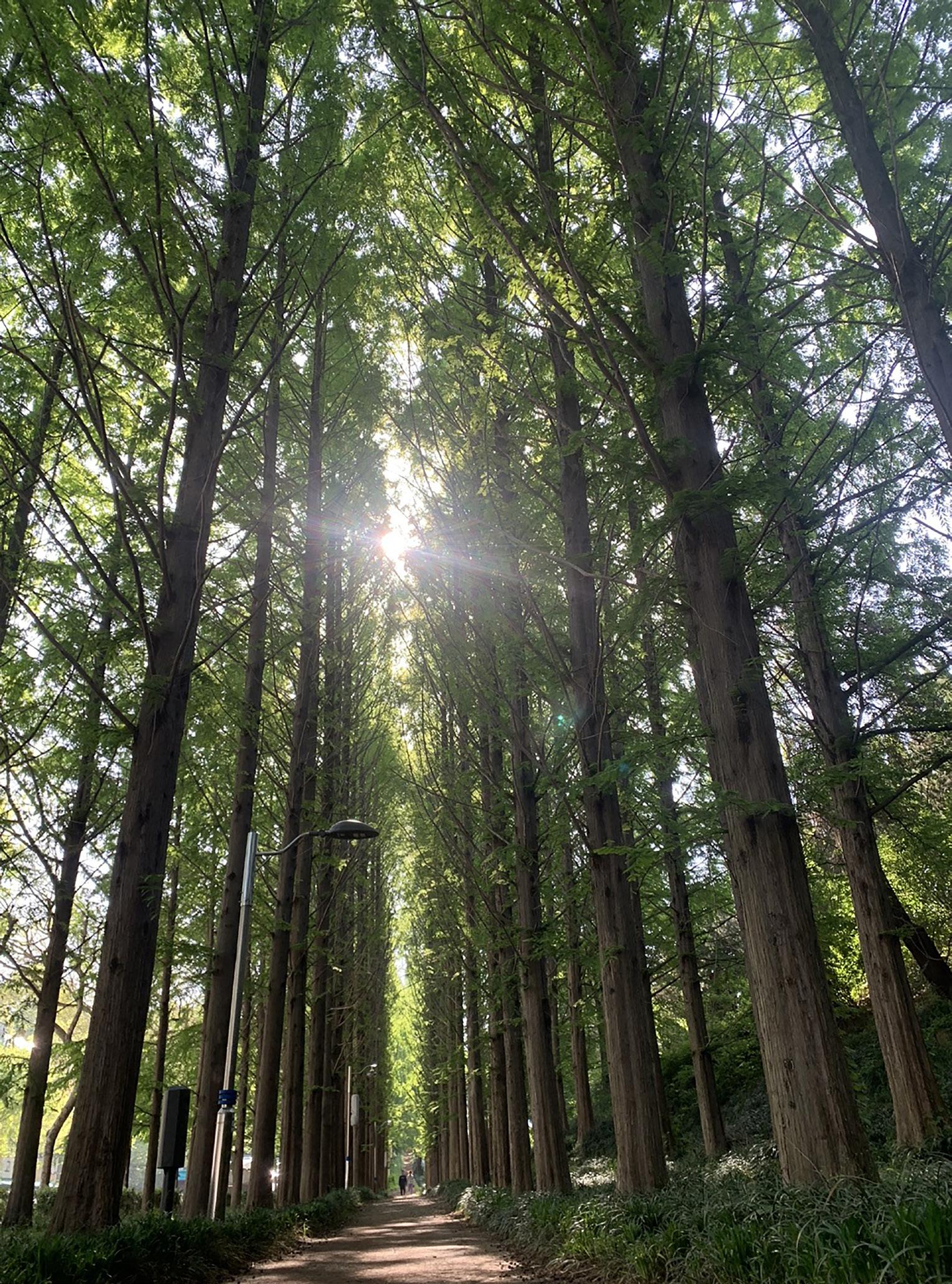
Wander where the trees reach high, and sunlight trickles from the sky.
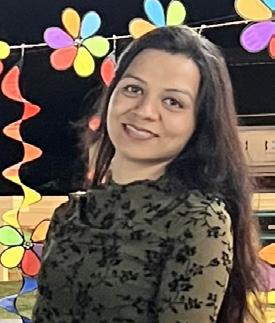
The Photographer
Neha Bisht is a native of India, pursuing her PhD at Chonnam National University. She loves to travel and likes capturing the historic and scenic views in her memories.
Photograph taken at Munhwa Neighborhood Park, Gwangju.
Cultural Barriers: Challenges Faced by International Undergraduate
26 “If You Have Something to Say, Just Say It!” – Dedicating Myself to Toastmasters
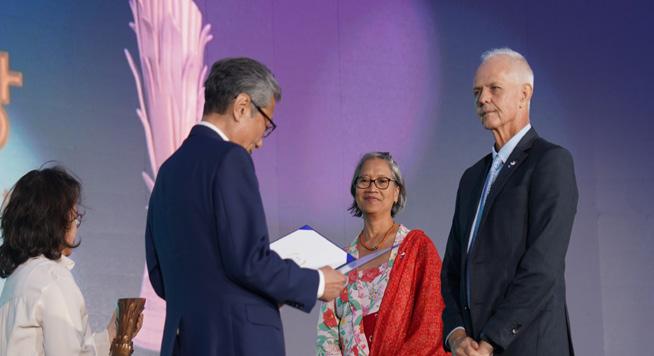
28 The Environment: Beware of Those Sweet, Sweet Smells – Synthetic Fragrance Pollution
30 Addressing Korea’s Low Birth Rate: 3-Plus Family Benefits for Foreigners
CULTURE AND THE ARTS
32 Ponderings & Contemplations: Celebrated Temples in the GwangjuJeonnam Region 34 Book Review: Stoner
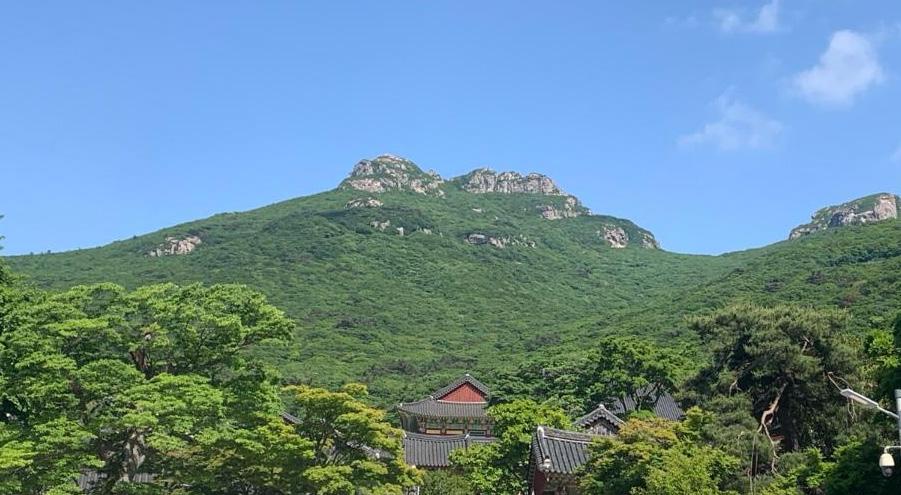
36 Azure Café: A Peaceful Pause in the Damyang Countryside 38 Restaurant Review: Nana Bangkok –A Taste of Thailand in Gwangju
& ENTERTAINMENT 40 Area Sports Round-Up 43 AI Peppers’ Taylor Fricano: A Season of Growth and Unfinished Business 45 June Upcoming Events
Credits 08 The May 18 Foundation. 15 KOGL/e-History Video Archives 17 Neha Bisht
The South Korean government has decided to hold the presidential election on Tuesday, June 3. That day will be a temporary public holiday so that more people can vote easily. As voting is an important part of democracy, the government wants to make sure everyone has a chance to vote. That’s why election days in Korea are usually public holidays.
To make the election fair, the Ministry of the Interior and Safety has set up a special team to watch and manage the election process. This team will work until the election is completed. Early voting will take place on May 29 and 30 (Thursday and Friday). Korean citizens who live in other countries can also vote early at Korean embassies. On June 3, voting will start at 6:00 a.m. and end at 8:00 p.m. After that time, no additional voting will be allowed.
Candidates for president registered on May 10 and 11. Many people are interested in this election because it is occurring earlier than usual after the previous president was impeached and removed from office. In a time of global uncertainty, leadership matters more than ever. The future direction of South Korea lies in the hands of its people – citizens who will soon cast their votes to choose the nation’s next president.
In South Korea, June is known as the “Month of Patriots and Veterans,” a time to honor the sacrifices of national heroes. Among the significant events in June is Memorial Day, which is observed on June 6. It is a day dedicated to remembering the patriotic martyrs and military personnel who gave their lives for the nation. This day holds special historical significance, especially for those who lost their lives during the Korean War (1950–1953).
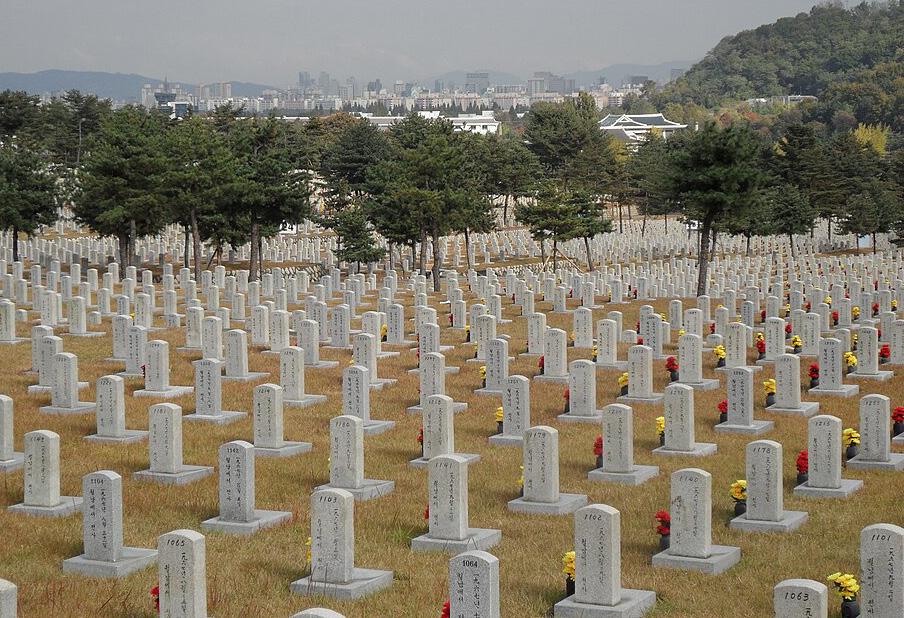
Seoul National Cemetery’s 26th Sanctuary.
Memorial Day, or Hyeonchung-il (현충일) in Korean, was officially established by presidential decree on April 19, 1956, and later became a government holiday in 1982, following amendments to the Regulation on National Holidays. While many people today see Memorial Day primarily as a public holiday, it is much more than just a day off. It is a solemn occasion to honor those who sacrificed their lives for the nation’s freedom and security.
On this day, all government buildings and many households fly the South Korean flag (Taegukgi) in remembrance of the fallen. At 10 a.m., sirens are sounded nationwide, marking a one-minute moment of silence in tribute to those who died for the nation. This act of silence is a time for reflection, where many South Koreans, after raising their flags early in the morning, participate in a collective moment of respect.
As we reflect on the sacrifices made by South Koreans, we must also remember the soldiers worldwide who continue to give their lives for the cause of peace. On this Memorial Day, let us take a moment to honor them as well.
SK Telecom (SKT), the largest telecommunications company in South Korea, was recently hacked. On April 19, SKT confirmed
that hackers leaked customer information related to SIM cards. The leaked information included unique identification numbers and key codes for customers’ SIM cards. This could lead to crimes like SIM card cloning or SIM swapping. SIM swapping occurs when someone uses your SIM card information in another phone to access authentication codes and financial messages. This can lead to hacking of bank accounts, scam messages, or stolen accounts.
After the incident, SKT recommended that all 25 million customers replace their SIM cards and sign up for a SIM protection service. This service blocks attempts to use the SIM card in another phone or to clone it. If any unusual activity is detected, the user will receive an alert. To help alleviate the problem, SKT is offering free SIM card replacements and protection services for all customers. However, many customers are complaining about the inconvenience of the service, as there was a shortage of SIM cards at first.
Because of these problems, some SKT customers are filing lawsuits, and both the company and consumers are facing difficulties. It is hoped that international customers using SKT’s services can also get the protection they need to avoid further issues.
As summer approaches, Gwangju City is preparing to combat rising temperatures with a range of public safety measures. June marks the beginning of Korea’s hot season, and city officials are taking proactive steps to protect all residents – including the elderly, children, and foreign nationals – from the dangers of extreme heat.
One of the key efforts includes the expansion of “cooling centers” (무더위 쉼터) across the city. These air-conditioned spaces are available
at community centers, libraries, and some subway stations. They provide a safe and cool environment for anyone seeking relief from the heat.

In addition, the Gwangju local government is distributing multilingual safety leaflets to ensure that foreign residents are also well-informed. These leaflets include tips such as (a) Drink plenty of water regularly, even if you’re not thirsty, (b) Avoid outdoor activities during the hottest hours (typically 12 noon to 5 p.m.), (c) Wear lightweight and light-colored clothing, and (d) Check on neighbors, especially seniors and those living alone.
City workers will also be monitoring vulnerable populations, including low-income households and the elderly, through regular welfare checkins. Emergency cooling kits and fans are available upon request through neighborhood offices. Foreigners living in Gwangju can access heat safety resources via the Gwangju International Center (GIC) or by calling the 1345 Immigration Helpline, which offers service in multiple languages.
The Gwangju mayor’s office emphasized, “Summer heatwaves are not just uncomfortable – they can be life-threatening. We want to make sure that every resident, regardless of nationality, feels supported and safe.” With these communitywide efforts, Gwangju continues to set an example of inclusive public safety and climate resilience.
Compiled by Kim Jinyoung.
The May 18 Memorial Foundation initiated the Gwangju Prize for Human Rights in the year 2000 to honor individuals, groups, or institutions that have contributed to the promotion and advancement of human rights, democracy, and peace, commemorating the spirit of the May 18 Democratization Movement.
The non-governmental organization Asia Justice and Rights (AJAR) was awarded the 2025 Gwangju Prize for Human Rights in recognition of its unwavering commitment to restoring human rights and building peace across Southeast Asia. Based in Indonesia, AJAR has worked extensively in countries such as East Timor, Myanmar, Thailand, and Bangladesh, supporting victims of state violence and largescale human rights abuses.
Mr. Patrick Burgess was kind enough to set aside his time to meet with the Gwangju News just prior to the Gwangju Prize awarding ceremony. We present you with that interview:
Gwangju News (GN): Thank you, Patrick, for granting this interview. Would you first introduce yourself briefly for our readers?
Patrick Burgess: Yes, I am an Australian lawyer. I used to be a barrister, and I was the senior member and, for a time, the acting head of the Australian refugee tribunal. I have been living in Asia for 30 years, and I’ve been working on mass atrocities and human rights for more than 35 years. I was also the director of human rights for two United Nations peacekeeping missions in Timor-Leste, and I have been a transitional justice expert in more than 20 countries.
GN: Can you describe the founding vision of AJAR and how it has evolved since its establishment in 2010?
Patrick Burgess: About 15 years ago, Galuh Wandita and I decided to form AJAR (Asia Justice and Rights) because the word ajar means “to teach” or “to learn” in Indonesian. We set up our base in Jakarta, and we wanted to form an organization that worked not in just one country
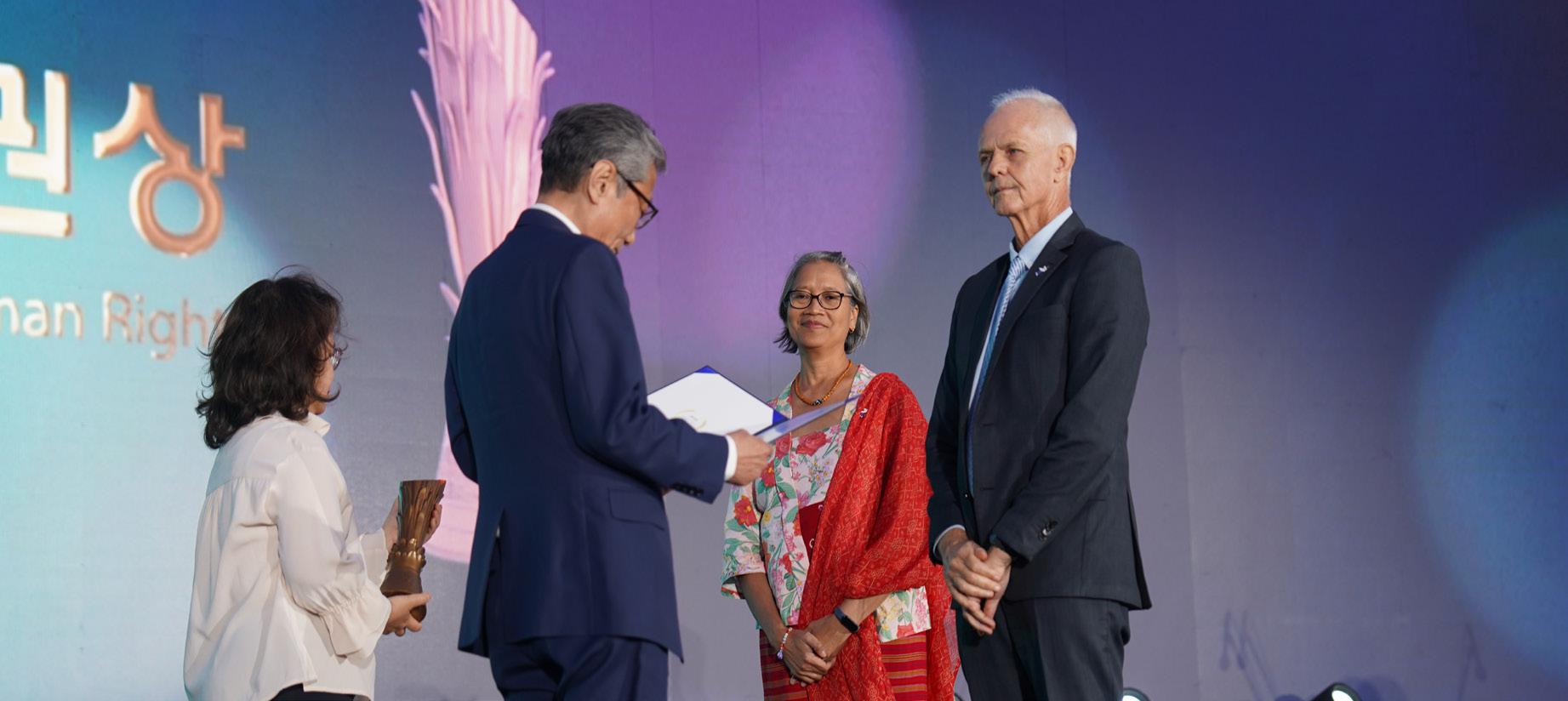
but across the region, looking at human rights violations in the form of mass atrocities. The lessons that can be learned are how to deal with mass atrocity, how to achieve truth and justice, and how to pass those messages on. There are also many lessons we can learn and teach from Gwangju’s experiences.
Dealings with mass atrocities were centered mostly in Europe, North America, Latin America, and South Africa. But we found many cases of mass atrocities in Asia. That’s why we formed Asia Justice and Rights, and we set it up with its headquarters in Jakarta because Jakarta has the secretariat for ASEAN.
GN: What strategies does AJAR employ to support communities affected by large-scale human rights violations, particularly in regions like Myanmar and Timor-Leste?
Patrick Burgess: AJAR’s mission is to work with human rights defenders, to help survivors form groups to link to each other, to find their voice, to strengthen their voices, to teach about international human rights, and to link them to the United Nations, the international criminal court, and other mechanisms. Our job is to bring people together to empower them, educate them, and then continue to support them in their struggle in their own countries.
AJAR has worked very closely in Timor-Leste. I myself went there in 1998 and was hired by the United Nations to help with the ballot for independence. I went there for three months, but when everything fell apart and there was mass violence, I stayed for six years. And that’s where Galuh Wandita and I started to work together.
Since that time, we have continued to work in Timor-Leste. We worked there when the violence was very bad and when everything was destroyed. We continued to work as the democracy was built. Even today, we have an academy for human rights, teaching school children and university students about what took place, about how to recognize its root causes and authoritarianism, and how to fight corruption and nepotism.
In Myanmar, we face a serious situation where severe mass atrocities are being committed on a daily basis. The military junta received about six percent of the vote in the election at the end of 2020. They claimed that it was fraudulent. The European Union and others said it was free and fair. But the military junta took over the entire country.
What’s amazing and inspirational is that the people are saying they will never accept this military junta. We will not accept the junta, which locked up and tortured to death around 2,000 young people and others who were demonstrating.
“We have projects supported by the European Union, the Swiss government, and some other governments and foundations. ”
But now, step-by-step, the people have banded together and learned how to fight – ordinary people like in Gwangju, taxi drivers and housewives are bonding together. In Myanmar, the lawyers, the students, the musicians, and the actors are carrying guns though they don’t want to bear arms.
The people have won back more than fifty percent of the country so far. So it’s a great honor to stand beside them. We have a team, a Burmese pop group on the Thai-Myanmar border.
We have another team in the Bangladesh refugee camps with the Rohingya people. More than 1.5 million of them are living in refugee camps, having been attacked and killed and raped by the Burmese military and driven out of the country in an act of ethnic cleansing. And we have another team in Jakarta working on advocacy with ASEAN countries and with the ASEAN secretariat.
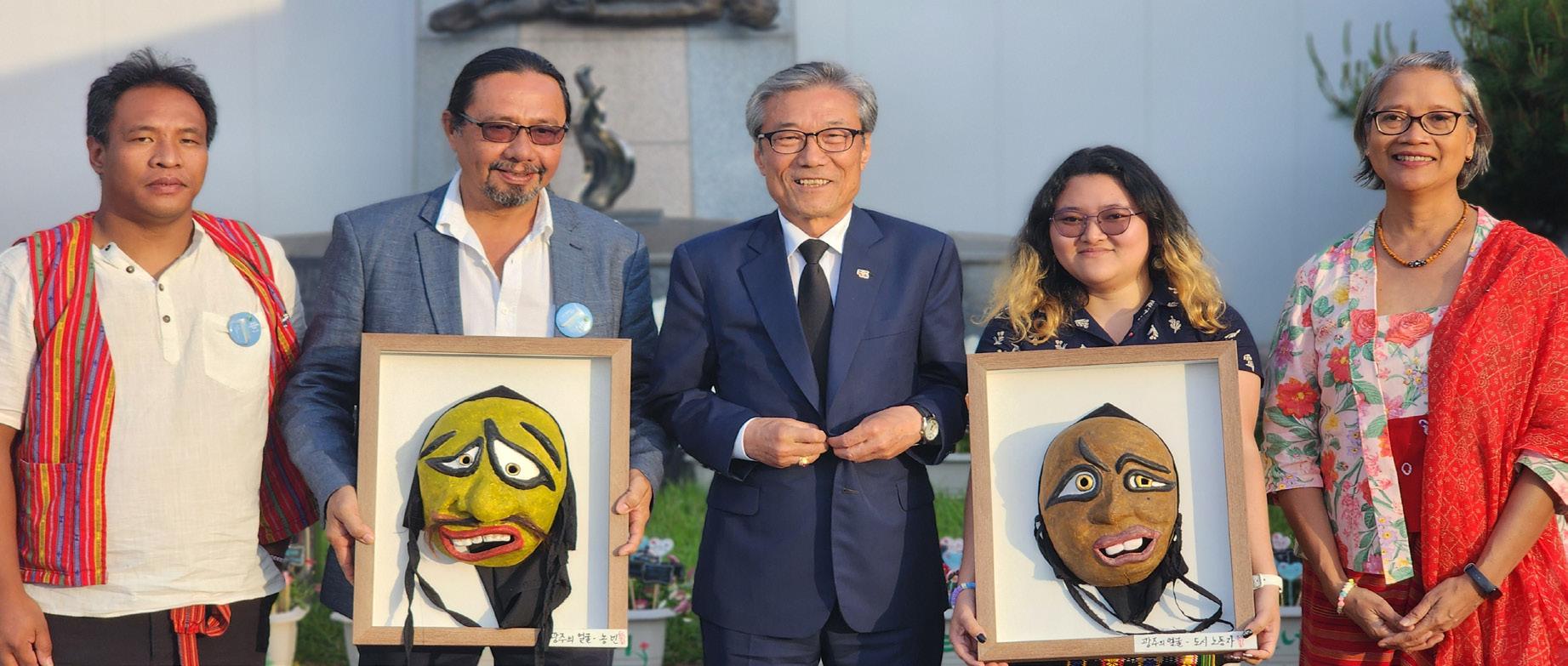
GN: I wonder how you handle financing your enormous projects and recruiting talented people to work with you.
Patrick Burgess: Yes, it’s always been a struggle to receive sufficient funding for human rights work. And now in the last six months to a year, it’s become much more difficult, especially with the United States changing their policy, and some of the European governments cutting back. AJAR is supported by a broad range of donors. We have projects supported by the European Union, the Swiss government, and some other governments and foundations.
We have an office in Jakarta with a training center, a human rights center in Bali, an office in TimorLeste, one office on the Thai-Myanmar border, and one in Bangladesh. We also have a small office in Sydney, Australia, that acts as a support office to raise funds and support for our work. So it’s always a struggle to raise enough funds. I think that it is very helpful that we decided to be based in Jakarta and in other offices in the Asian context, where the price of an office and the staff salaries are much lower than in other countries.
We try to run things like a family. So we care for each other. We use music and theater and film; we often go away together, if we can, to work on issues with our counterparts and survivors. And so, people like to work for AJAR. They feel that it nurtures them, and we have a very flat structure.
We don’t operate in a top-down way, and I think that’s the key to us being able to recruit and maintain wonderful staff.
We do spend a lot of time preparing proposals applying for funding and then, of course, reporting to donors. That’s a part of the human rights work. But we find that the more good work we do, the easier that becomes, but in this day and age, for all human rights organizations, it’s a struggle.
GN: How does AJAR utilize media, such as film and social media, to promote your cause at this time of digital media?
Patrick Burgess: In this world of mass media, we have to recognize that information flows in a different way than it has in the past. People are reading less, and they’re watching more. Young people listen to music more than ever.
Almost all day we use music. I’m also a professional musician, a songwriter, and a lot of my songs focus on storytelling about justice and human rights issues. I have a song about a taxi driver in Jakarta. I have one set in Cambodia, and one in Myanmar that will come out soon. I don't have one yet about South Korea, but maybe I should write a song about Gwangju.
We also use TV films. We have a recent film about the Rohingya that’s just won its fourth prize. We
gave Rohingya refugees cameras to film their own life in the camps, and we put that together. And I was the producer of that film. It’s called More Than a Refugee, meaning that we often put the label “refugee” on people, but each one of them is much more than that. This film was shown in New York last week and will be shown in Finland this month, as it’s won awards in both New York and Finland.
GN: What additional projects would you like to share with the Gwangju News readers?
Patrick Burgess: We have a number of projects that I’m very proud of. One of them is the project of the stolen Timor-Leste children during the military occupation by the Indonesian military. With no journalists allowed in there, the Indonesian military began the process of taking children from their families, and they took many thousands of children from their families. Some were used as extra help in households.
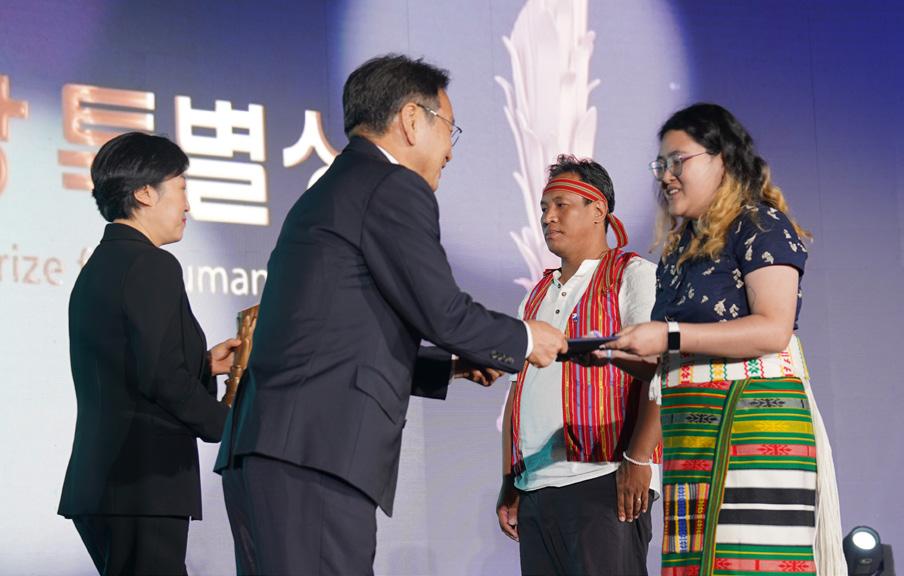
The awarding of the Gwangju Prize for Human Rights’ 2025 Special Prize to Dap-ayan ti Kultura iti Kordilyera (DKK; People’s Center for Cordillera Culture) for its work in defending indigenous rights and preserving collective memory through cultural expression.
A few were helped. Many were abused, and they took them to Indonesia. The families never heard from their child again. So AJAR, 30 years later, has been very slowly and with a lot of effort tracing these children in Indonesia.
If these stolen children can remember their village name – many of them can’t – we try to trace the family and bring them back to rejoin their family. We found about 200 so far, and there’s been a great reconciliation between the two countries for the past evil done.
We also have one flagship program called Stones and Flowers for victims of sexual assault. That’s a process because you can find stones and flowers in every village. The program is part of AJAR’s broader effort to address impunity, promote healing, and empower survivors through participatory action research and communitybased healing methods.
People use Stones and Flowers to explore their stories. We record those stories, with their storyteller’s agreement, and share them with others. We’ve worked with more than 1,000 survivors of sexual violence across Asia.
GN: What messages do you want to share with the citizens of Gwangju at this time of the 45th anniversary of the May 18 Democratization Movement?
Patrick Burgess: The example of Gwangju is incredibly important for this region, and for the whole world, because we need examples of where it has been successful, where we’ve overcome authoritarianism, and where we’ve achieved a democracy. Now we see this movement to denial: There are Germans saying that the Holocaust never happened. There are Cambodians saying that the Khmer Rouge massacre never happened. There are Indonesians denying that the massacre of one million people by Soeharto never happened and wanting to make him a hero.
There are all these issues that are in danger of being undone because the truth of the past is not being diligently supported. The courage and inspiration of those who fought for democracy is not celebrated. In Gwangju, however, I see that. This is one of the best examples anywhere in the world. And I’ve been working on this for a long time, and I will take that with me. The Gwangju Prize for Human Rights is also a wonderful symbol. I’m in great debt to Gwangju for the lessons that the people of Gwangju have given me.

Interview conducted by Dr. Shin Gyonggu Photographs courtesy of The May 18 Foundation.
By John Feffer
The United States, under Donald Trump, has stepped back from the role of promoting democracy and human rights that it has selectively pursued for several decades. Over the last few months, the Trump administration has sought to end all U.S. programs supporting democracy and human rights activists around the world. For those struggling to end authoritarianism in places like Russia or Myanmar, the termination of U.S. funding for media, training in language and governance, and assistance for refugees is catastrophic.
It’s true that U.S. aid has always been subordinated to U.S. national priorities. There has been very little programming in support of democracy in certain allied autocracies like Saudi Arabia. Much of the assistance from Washington has been imbued with U.S.-centric philosophies of specific democratic structures and market-based reforms. And of course, the United States has its own history of supporting anti-democratic forces around the world – including the government of Chun Doo-hwan in 1980.
But the retreat of the United States from the promotion of human rights, however flawed those efforts might have been, is now emboldening autocratic leaders around the world. They no longer have to worry that Washington will complain about their suppression of fundamental rights. Indeed, Trump has boasted of his close relationship with rights-abusing leaders from Vladimir Putin in Russia to Nayib Bukele in El Salvador.
At Gwangju’s recent Gwangju Democracy Forum in May, activists from around the world discussed the challenges posed by the global retreat from democracy and human rights. But there was one especially bright spot in recent world news: the overturning of Yoon Suk Yeol’s martial law decree, his impeachment by the National Assembly, and the Constitutional Court’s verdict upholding that impeachment decision. There was considerable hope among Forum participants that the June elections would represent a recommitment to democracy in Korea, not only the procedural democracy that Yoon violated but the more substantive democracy represented by a vibrant civil society and a free media.
“Activists from around Asia spoke of how the Korea example inspired them to continue their work.”
One after another, activists from around Asia spoke of how the Korean example inspired them to continue their work, even as autocratic leaders have expanded their power in many countries, including the United States. These activists were also heartened by the example of Gwangju, of how activists in the city protested an earlier declaration of martial law – the declaration by Chun Doo-hwan on May 17, 1980 – and how the residents of the city supported their acts of courage.
That Gwangju spirit – the Spirit of May –reached across the decades to embolden Korean citizens and lawmakers to resist the martial law declaration of December 2024. Indeed, one of the recommendations of the recent Gwangju forum was to enshrine the Gwangju example in the preamble to the Korean constitution.
The retreat of the United States from its support of democracy and human rights is distressing, but it can also be an opportunity. Other countries can take the opportunity to step up their own work in promoting these universal values around the world. South Korea should be at the top of the list of countries that take advantage of this opportunity. Korea can focus in particular on upholding higher political standards for the Asian region – by pressing for democratic reforms through its comprehensive strategic partnership with ASEAN, by bringing more activists to Korea for study and exposure tours, by providing financial support for movements for democracy and human rights throughout the region.
“That Gwangju spirit – the Spirit of May – reached across the decades to embolden Korean citizens and lawmakers to resist the martial law declaration of December 2024..”
Korea is in many ways better suited for this role than the United States ever was. It has a more recent experience of democratization that speaks more directly to countries currently experiencing political upheaval. It has dealt nonviolently and successfully with the very recent threat of martial law in 2024. And it doesn’t have the kind of imperial baggage that the United States brings to any conversation about democracy and human rights.
Over the last few decades, Gwangju has become more prominent in engaging with activists throughout the region and the world through the May 18 Foundation and the Gwangju International Center. The country’s opportunity to take a larger role in promoting democracy and human rights is also an opportunity for Gwangju. International organizations devoted to these issues should recognize the symbolic importance of Gwangju and establish their headquarters there, turning the city into a global center of democracy and human rights.
Those who struggled in 1980 against martial law were hoping against hope that their actions would lead someday to a democratic Korea. Years later, their hopes have been realized, but now the spirit of Gwangju is needed for an even bigger battle: to fight back against global forces of autocracy. The situation today is dire, but no more dire than the political environment in South Korea in May 1980. The people of Gwangju have much to teach the world about sticking to principles, acting with courage, and imagining a more just and equal world arising out of the ashes of the present.

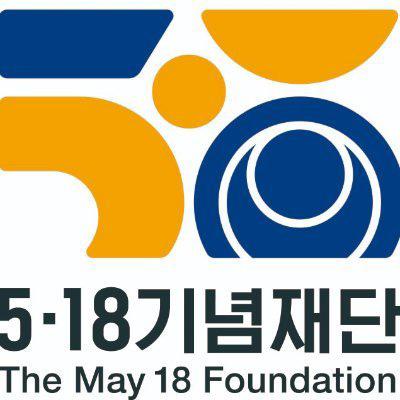
The Author
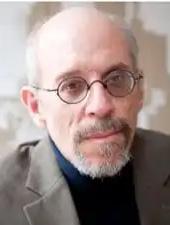
John Feffer is the director of Foreign Policy in Focus and of Global Just Transition at the U.S.-based Institute for Policy Studies. He is the author, most recently, of Right Across the World: The Global Networking of the Far Right and the Left Response. He has taught a graduate course on international conflict at Sungkonghoe University in Seoul. Mr. Feffer was recently invited to speak at the Gwangju Democracy Forum sponsored by the May 18 Foundation.
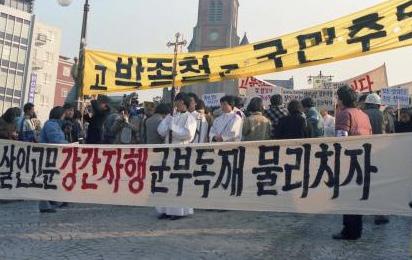
By Park Yeonju
“Ihit the desk, and he died saying, “Ah.”
This statement is what the police initially announced as the cause of death of student protester Park Jong-cheol in 1987. But the autopsy revealed that his death was caused by electrical and water torture. Students and citizens were outraged and took to the streets to mourn the death of Park. This incident became a key catalyst for the June Democratic Struggle and helped build a strong public consensus for the pro-democracy movement.
The year 1987 burned with an intense desire for democracy and marked a new turning point in its history. In 1987, a new constitution reflecting the will of the people was born. And during that time, the entire nation cried out for democracy – this was the June Democratic Struggle of 1987.
The 1987 June Struggle was an anti-dictatorship democratization movement that took place nationwide from June 10 to 29, triggered by the torture death of Park Jong-cheol. The Struggle was ignited by three major incidents: the torture and death of Park, the April 13 declaration to uphold the authoritarian constitution, and the death of student protester Lee Han-yeol after
being hit by a tear gas canister. Let’s follow the timeline of the June Democratic Struggle.
Park Jong-cheol was a junior linguistics student at Seoul National University. On January 13, 1987, he was arrested by six investigators from the Anti-Communist Investigation Division of the National Police Headquarters. He was arrested as part of an effort to apprehend Park Jongun, a senior member of the University Culture Research Society and the Democratization Promotion Committee. The police subjected Park Jong-cheol to brutal physical assault, electrical torture, and water torture. He ultimately died in the interrogation room on January 14. After Park’s death, the police attempted to fabricate the circumstances, claiming that he had died at the hospital.
The next day, several media outlets reported that Park had suddenly collapsed and died while being transferred to a hospital. They added that he had been taken into custody for allegedly harboring Park Jong-un, which was not true. It was then that the now-infamous statement emerged: When an investigator slammed the desk while asking about Park Jong-un’s whereabouts, Park Jong-cheol let
out a gasp and collapsed. This assertion was made by Kang Min-chang, chief of the National Police Headquarters. It was absurdly publicized as the official cause of death.
Even the newly appointed Minister of the Interior, Chung Ho-yong, denied the torture. He said, “How could a person possibly beat another person?” Chung had previously served as the commander of the Special Forces. He was the highest-ranking officer in the unit that led the crackdown during the May 18 Democratic Uprising in Gwangju. That very person once again claimed that there had been “no violence at all.” However, the autopsy revealed that the cause of death was asphyxiation due to water torture. During the torture, his neck was pressed against the edge of the bathtub, leading to suffocation. The prosecutors in charge of the case who chose to reveal the truth were later demoted.
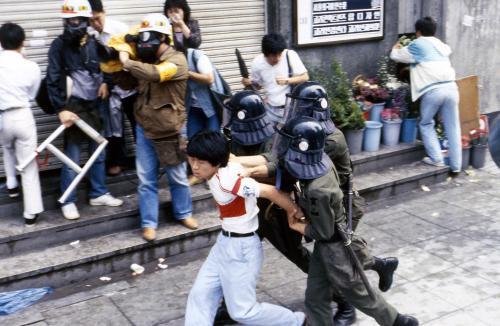
Park Jong-cheol’s pan-national memorial service and downtown protests were held in major cities across the country on February 7. The 49th memorial service for Park and the national march for a ban on torture followed on March 3. But President Chun Doo-hwan rejected the growing public demand for democratic change. Instead, on April 13, he delivered a Special Presidential Address announcing the suspension of constitutional amendment talks.
At the time, South Korea stood at a crossroads: whether to maintain the existing constitution and elect the president through an electoral college or to amend the constitution and introduce direct presidential elections by popular vote.
Despite interference from President Chun Doohwan, the opposition party – the New Korea Democratic Party (NKDP) – emerged as the leading opposition force in the general election held on February 12, 1985. Led by Kim Youngsam and Kim Dae-jung, the NKDP stood in direct opposition to Chun’s ruling regime.
On February 12, 1986, marking the first anniversary of the general election, the NKDP launched the Ten Million Signatures Campaign for Constitutional Reform. The constitutional reform movement gained momentum, and on April 30, President Chun Doo-hwan announced that he was willing to agree to a constitutional amendment. However, Chun proposed a shift to a parliamentary system, while Kim Young-sam and Kim Dae-jung demanded a presidential system with direct elections. The gap between their positions was too wide to bridge. Meanwhile, Chun’s regime continued to crack down on pro-democracy movements, further fueling the public’s demand for reform.
Under the banner of the so-called AntiAmendment Measure, the Chun government announced its intention to transfer power under the existing constitution. Officials believed the move would generate strong public support. Instead, it provoked widespread backlash. President Chun sought to maintain the indirect presidential election system enshrined in the then-current constitution, a stance that ignited fierce opposition among citizens demanding direct presidential elections.
On May 18, 1987, a memorial mass marking the seventh anniversary of the Gwangju Uprising was held at Myeongdong Cathedral in Seoul. During the service, Father Kim Seung-hoon of the Catholic Priests’ Association for Justice revealed that police had covered up the torture and death of Park Jong-cheol. The revelation fueled public anger among citizens already critical of Chun’s Fifth Republic regime and sparked protests demanding democratization across the country.
On June 9, student protester Lee Han-yeol was hit in the back of the head by a tear gas canister
fired by police in front of the main gate of Yonsei University. He collapsed at the scene. The next day on June 10, the Chun Doo-hwan regime announced that Roh Tae-woo, a key political ally of Chun, would be the ruling party’s presidential candidate. That same day a largescale demonstration broke out at Seoul City Hall Square. Opposition leaders, university students, and office workers in their 30s took to the streets. The protests quickly spread nationwide.
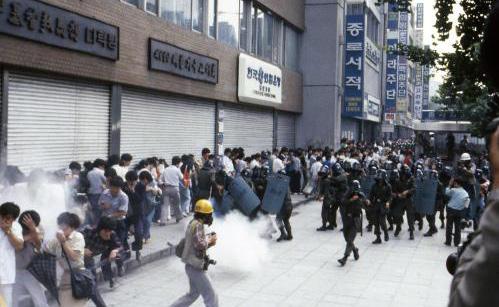
After June 10, an average of more than 100 protests took place simultaneously every day across the country. It is estimated that four to five million people participated in the June Democratic Struggle. Eventually, the Chun Doo-hwan administration had no choice but to accept the request for an amendment to the direct presidential election system through the June 29, 1987 Declaration of Democracy. After the amendment for the direct election system, Korean society entered the stage of full-fledged democratization. The June Democratic Struggle blocked the dictatorship’s intention of extended rule through civil resistance. The achievement of constitutional reform introducing direct presidential elections was highly significant. It marked a decisive turning point for democratic values and institutions to take root across political, social, and cultural spheres.
It was a struggle that unfolded across the entire country, involving workers, students, the poor, and farmers – people from all sectors of society. What is the connection between the May 18 Democratic Uprising and the June Democratic Struggle? I want to say that the democratization of Korea achieved through the June Democratic
Struggle was only possible because of the May 18 Gwangju Uprising.
The memory of the May 18 struggle, which continued unabated, laid the foundation. At that time, heightened anti-American sentiment meant that the U.S. military had no choice but to support the Korean people during the June Democratic Struggle for the sake of public sentiment. It was unreasonable for the Korean military, which had already lost its legitimacy, to suppress the uprising solely by following Chun Doo-hwan’s orders. The military had witnessed the power of the people during the May 18 period.
It was clear why neither Chun Doo-hwan nor the military could intervene. The history of May 18 and its undiminished memory showed how great the desire for democratization in Korea was. The June Democratic Struggle also forced the government to announce sweeping reforms. These included the introduction of direct presidential elections and constitutional amendments. Afterward, a broader wave of democratization and liberalization emerged across South Korean society. The Ninth Amendment to the Constitution, enacted in the aftermath of the protests, laid the foundation for what is now commonly referred to as the “1987 system.” This system continues to serve as the framework for South Korea’s political and legal order today. As the entire nation came together and cried out for democracy in 1987, we are now able to live within the values of democracy. The slogan “Abolish the constitutional amendment, overthrow the dictatorship, and achieve democracy” is what shaped today’s Republic of Korea.


Park Yeonju is an undergraduate at Chonnam National University, majoring in political science and diplomacy as well as Chinese language and literature. Her third major is international development cooperation studies. She was born and raised in Gwangju and wants to promote the colorfulness of the city that she has been a part of for so long.
By Neha Bisht
There are places that impress you – and then there are places that imprint you.
Daeheung Temple, nestled deep within the quiet folds of South Jeolla’s Duryun Mountain, became more than just a stop on a travel itinerary. It became a soft-spoken reminder of stillness, sacredness, and the quiet beauty of slowing down.
My journey to this hidden sanctuary began with a university-organized tour, something many students signed up for, drawn by its unusual combination of nature, tradition, and spiritual calm. I joined out of curiosity – but also from a quiet desire to step away from the noise of everyday life, the rush of deadlines, and the constant demands we all carry without noticing.
The temple is not immediately visible from the entrance. To get there, we first walked through a forest along a long, shaded path. The area was surrounded by tall, old trees, and the cool air carried the natural scent of pine needles, fallen leaves, and mountain moss. The quiet
environment made everyone naturally slow down and take in the surroundings. It felt like a calm and gradual transition into a more peaceful space.
After walking through the forest, we reached a small tea house at the edge of the woods where the monks welcomed us with kind smiles. After a short rest, they handed us traditional clothing and small baskets, inviting us to join in the ageold ritual of tea leaf picking. Together with my friends, I followed the monks into a nearby tea garden. The morning light was soft, filtering through the leaves as we moved among rows of tea bushes, learning to pick the delicate top leaves with care. It wasn’t about skill; it was about being present. In that moment, surrounded by mountain air and quiet purpose, I began to feel myself arriving – not just at a destination but in the moment itself.
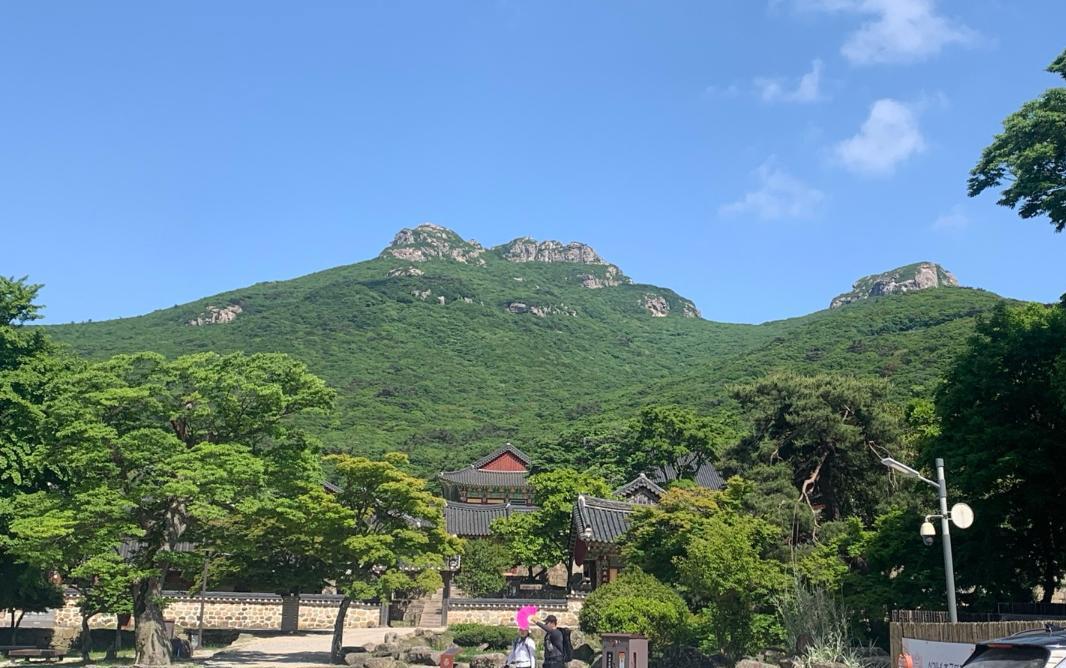
After finishing the tea leaf picking, we returned to the tea house to continue the tea-making
The mountain behind Daeheung Temple forms a natural silhouette resembling a reclining Buddha in meditation.
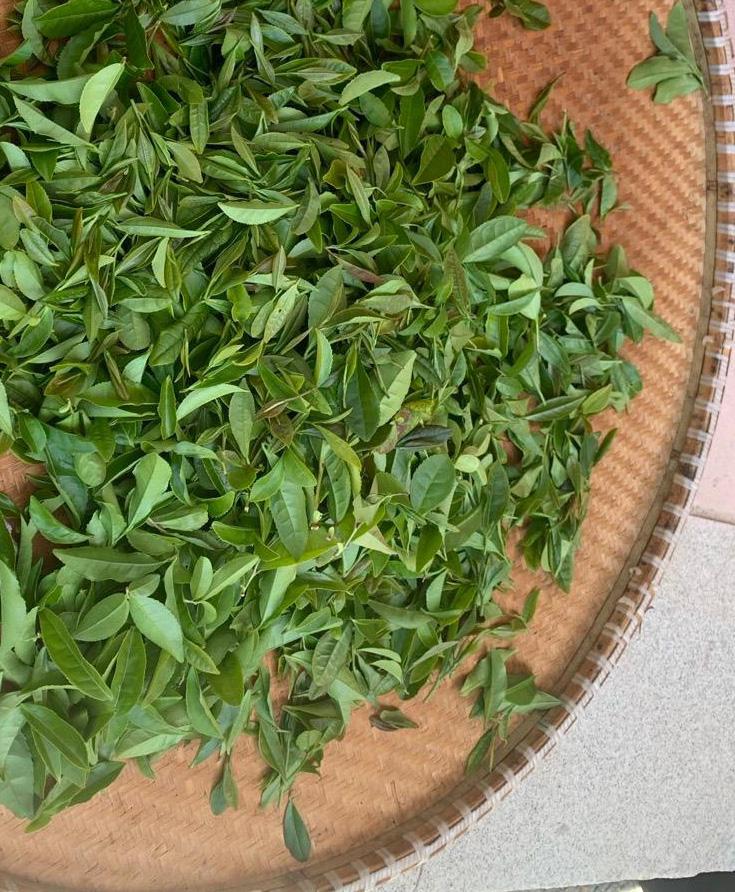
process. The monks guided us through the next steps, explaining that roasting and drying the tea usually takes three to five days. Since we had limited time, we took part only in the initial roasting. For the mixing step, we used preroasted tea leaves that had been prepared earlier by the monks. The process was done entirely by hand, a slow, circular motion that felt like a quiet ritual rather than a task. It was a calm and focused activity, and during this process, I found myself becoming more relaxed and engaged with the experience.
From the tea house, we continued our visit by heading toward the main temple area. The path led us through a quiet forest, creating a sense of separation from the outside world. It created a calm environment that prepared us for what we were about to experience. Eventually, the temple came into view. There was no large gate or elaborate entrance. Instead, we saw a group of wooden buildings set naturally against the mountain slope. The structures were simple and traditional, with curved tile roofs and aged
wooden walls. Rather than being impressive because of their size, they stood out because of how well they blended with the surroundings. It felt like the temple belonged there, as much a part of the landscape as the trees around it.
Inside the temple grounds, a deep stillness embraced everything. It wasn’t a silence of absence, but a silence full of presence. I slipped off my shoes and entered Daeungjeon, the main hall of the temple. A golden statue of Buddha sat at its center, surrounded by intricate lotus carvings. I sat quietly for a few minutes, observing the soft candlelight and the smell of incense. The silence made it easier to focus – not on anything specific but simply on being in the moment. The monks shared stories about the temple’s history and its spiritual significance. We captured the serene beauty of the scene, framed by the surrounding mountains, and spent a while longer soaking in the tranquility. As we left, the temple staff handed us eco-friendly bags – a thoughtful gesture that reflected their respect for nature and mindfulness.
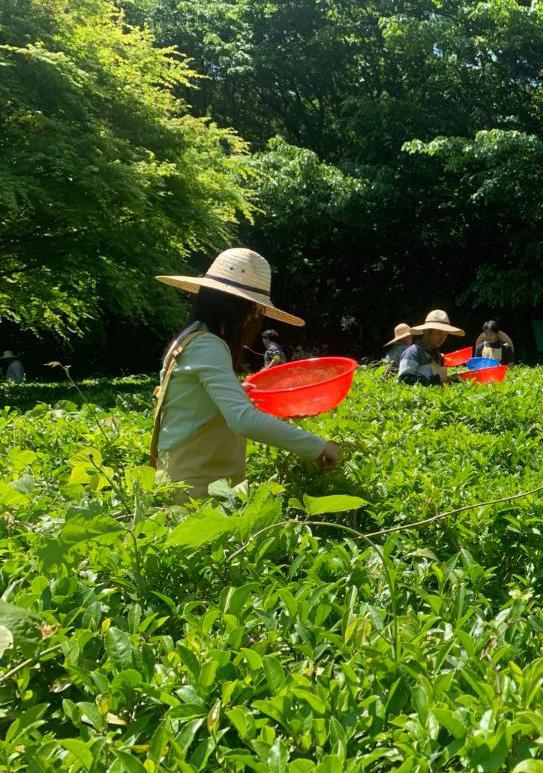
Later, we returned to the tea house, where a teasharing session had been prepared. The monks served mountain-grown tea along with a few traditional Korean snacks. We all sat together, drinking tea and enjoying the relaxed atmosphere. The warmth of the cup in my hands, the deep herbal notes of the tea, the rustle of leaves outside the open doors – it all felt like a shared silence, a collective exhale.
Daeheung Temple’s history stretches back to the Baekje Kingdom of the 4th century. Over the centuries, it has witnessed countless changes –from dynasties to invasions – yet its core purpose has remained the same. It continues to be a peaceful retreat for visitors seeking reflection, rest, or simply a break from the pace of daily life.
As we walked back through the forest at sunset, with the sky fading into shades of gold and pink, I realized I felt different from when I had arrived. I had come with a busy mind and quiet stress that I hadn’t even recognized. But I left feeling more


calm, more present, and more aware. The monk’s words echoed in my mind: “Mountains do not speak, but they are never silent.”
Daeheung Temple didn’t give me answers. Instead, it offered me space – space to pause, to think, and to step away from the rush of everyday life. What began as a cultural visit turned into something more meaningful. It became a moment of clarity and calm in my own personal journey.

Photographs by Neha Bisht.
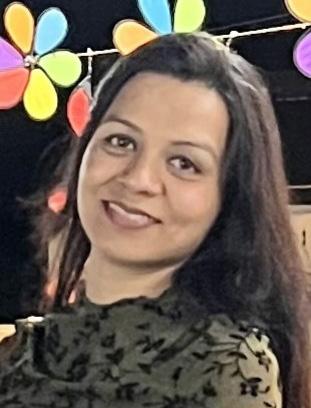
A native of India, Neha Bisht is pursuing her PhD research at Chonnam National University’s School of Materials Science and Engineering. She loves to meet new people and make new friends. Neha endeavors to contribute to the wellbeing of society in whatever way she can.
By David J. Richter
With most people in Korea living in apartment blocks or one-rooms, not everyone has the space to easily store a bicycle at their home. And to be fair, within the city of Gwangju, biking is not always the most comfortable means of transport. Many bike lanes in the city are simply a sidewalk colored red, with pedestrians and cars alike not giving much consideration to the idea of bikes being a part of traffic flow. So it is somewhat understandable that one does not see too many bikes on a dayto-day basis or that someone might choose to save the money of buying a bike in light of these limitations.
“Riding in between all the crop fields and mountains is incredibly beautiful and rewarding. ”
However, once one leaves the city limits (or rides on the riverbanks within the city) biking becomes much more fun and much less of a headache. Following the riverbanks up to Damyang or south to Mokpo, or simply leaving the city limits and riding in between all the crop fields and mountains is incredibly beautiful and rewarding. Doing so also saves one from having to ride over too much elevation. Such bike trips could be a simple one-day round trip of only a couple of hours (as in the case of Damyang), or one could turn it into a multi-day affair and choose to go further (e.g., Mokpo). Either way, it is a ton of fun and something I would recommend everyone to at least try.
But buying a bike to “just try” to see if one likes this is a bit much. This is where bike rentals come in. With my family coming over to visit, I too had to look for a bike rental in Gwangju for the first time, and what I found was much better than what I had expected. It was both pain-
free, simple, cheap, quick, and convenient, and the bikes were also really nice. There might be multiple bike shops around the city, but I have so far only tried one.
The shop is called MIL Bike (밀바이크), and it is located just west of Champions Field. Renting a bike is as simple as going to the store, telling them whether you want a mountain bike or an e-bike (plus helmets), and telling them for how long you want to rent them. Then you pay and you are good to go. If you want to make sure that the kind of bike you want is available, you can also make a reservation online through Naver. Regular bikes were 20,000 won for a day with e-bikes being 5,000 won more.
The bikes are in good condition and good quality. Returning them is as simple as riding up to the shop and securing them to the bike rack with a provided lock and reporting to staff that the bikes are back. Such a bike rental should be possible for just about anyone in the city and hopefully opens the door for some fun, exciting, and beautiful bike trips in the Jeollanam-do area and beyond for anyone who is willing to give it a shot.


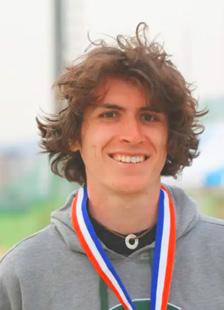
The Author David Jona Richter, born and raised in the extreme south of Germany, is a current graduate student at Chonnam National University. Before coming to Korea in late 2022, he spent about three years in Chicago in the U.S. Midwest. Besides his studies, he tries to engage in local communities in Gwangju and elsewhere in Korea.
By Dhivyaa S. P.
Sometimes, it only takes a fraction of a second for life to change entirely. For me, that moment came unexpectedly as I twisted my ankle while descending the stairs at my university. As I stumbled, a small voice inside my head whispered, “This time, it’s for real.” I barely had time to process what was happening before pain surged up my leg, sharp and unforgiving. A crowd gathered, but the noise around me blurred. Tears welled up uncontrollably.
I somehow managed to call 119. Thankfully, my year-long Korean language study paid off. I managed to explain the situation and shared my location. Within minutes, paramedics arrived, checked my vitals, and carefully helped me down the remaining stairs. They took me to a nearby hospital by ambulance – a first-time experience that felt both frightening and surreal.
At the hospital’s emergency ward, the medical staff collected my basic information and provided me with hospital attire. An initial series of X-rays was conducted, followed by a physical examination of my foot, to which I could only respond with an instinctive expression of pain. The attending physician then informed me that I would be admitted. That marked the beginning of a rapid sequence of further diagnostic procedures, including additional X-rays not only of my ankle but also of my chest and hips, followed by an MRI for the ankle.
While the medical staff were professional and kind, the language barrier became my biggest
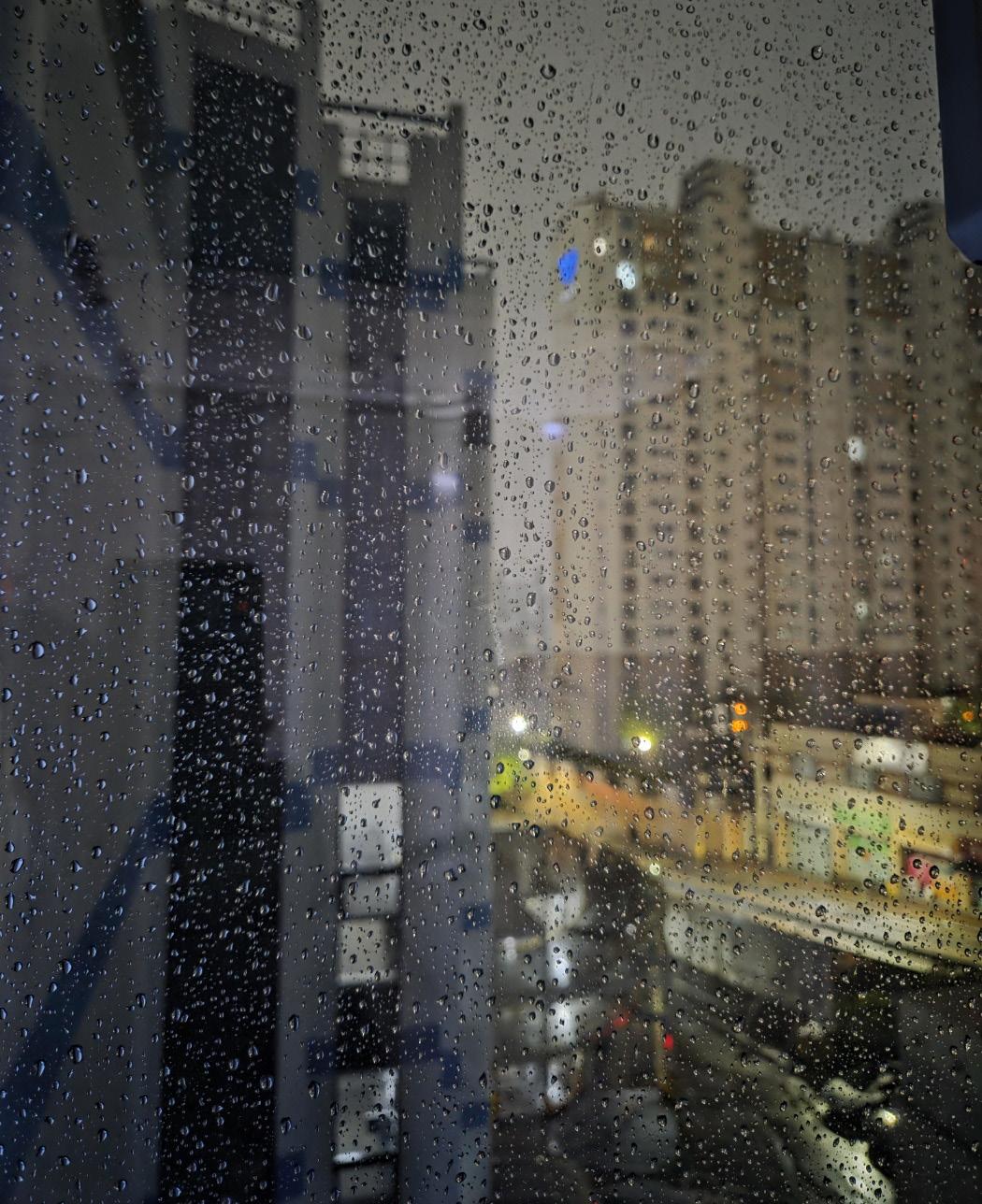
Behind the raindrops, a city moves on – while I pause, healing in solitude.
obstacle. I could understand basic Korean, but fear, pain, and financial worries clouded my focus. No one explained my condition in detail, which deepened my anxiety.
Soon, I was moved to a six-person room. In the evening, the orthopedic specialist visited and explained (as best he could) that I had torn two out of three ligaments and recommended surgery. That night was lonely. My two friends left, and as
darkness fell, panic set in. It was my first surgery. Nurses came in to explain admission procedures and provided several documents – everything in Korean – for me to sign. I was instructed not to eat or drink after midnight. Blood samples were taken for further tests. At 5 a.m., a nurse gave me a pre-surgery drink but still couldn’t confirm the surgery time.
Later that morning, my professor visited. She met the doctor, confirmed the surgery was necessary, and finally provided clear explanations. I felt immense relief. Additional heart and lung ultrasounds were conducted as part of emergency admission protocol.
Shortly thereafter, a nurse informed me that it was time to proceed to the operating room. My professor walked with me until the entrance
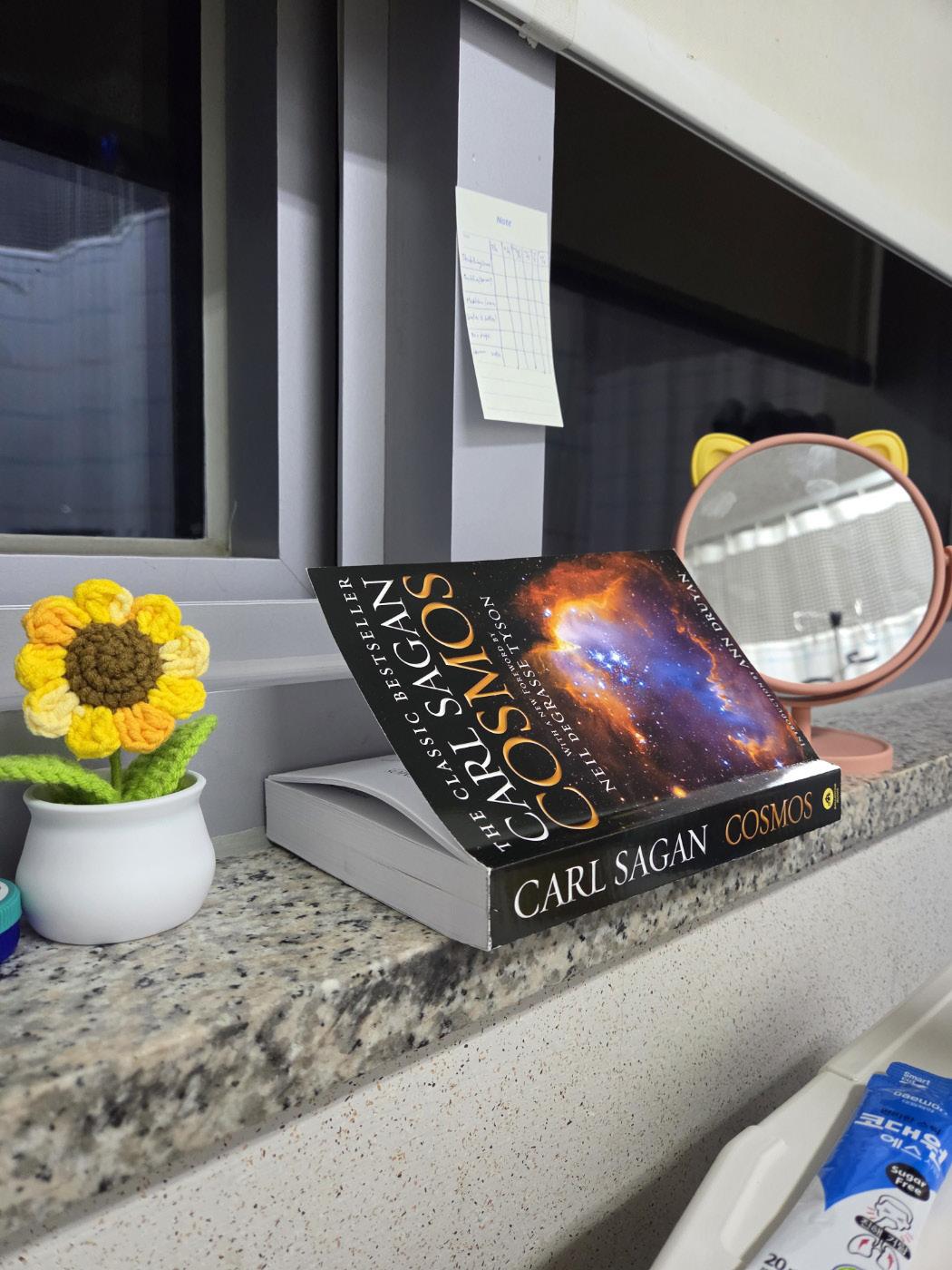
of the operating room, and held my hands – a moment of assurance I will never forget.
Upon arrival at the operating room, I changed into standard surgical garments and was prepared for the procedure in a cold and sterile environment. Observing the large surgical lights above, I was unable to suppress my tears. Noticing my distress, a nurse kindly comforted me in Korean, while another staff member offered brief but reassuring words in English, stating, “Don’t worry.” Just two words – but at that moment, they were everything. Soon after, anesthesia was administered, and I lost consciousness.
When I regained consciousness, the surgery had been completed successfully. I was transferred first to an observation ward for monitoring and then returned to my hospital room. The immediate postoperative period involved strict restrictions, including fasting until late afternoon and avoiding any sudden movements to prevent nausea. Throughout this time, I remained under the influence of strong pain medication and received continuous care from the nursing staff, who monitored my vital signs, changed IV lines, and administered painkillers as required.
The doctor informed me that I would need to stay for two weeks. Life in the hospital followed a routine:
• Meals at 8 a.m., 12 p.m., and 5:45 p.m.
• Hair wash service every other day.
• Visiting hours from 6 to 8 p.m.
• Access to shower rooms and a reading room (though books were in Korean).
• Vital checks three times daily.
• Rehabilitation center sessions to learn crutch walking.
Though the nurses were generally kind, many hesitated to speak due to my limited Korean. However, two nurses regularly checked on me, offering small talk that touched my heart deeply.
Emotionally, the solitude began to wear on me.

Two weeks in the hospital, away from family and navigating an unfamiliar language and healthcare system, was overwhelming. Thankfully, my friends visited often, keeping my spirits afloat.
“As an international student far from home, facing not only injury but also language and cultural barriers, it was undoubtedly challenging. ”
For payment, my National Health Insurance covered 67 percent of the costs, and with my professor’s help, I also received a doctor’s discount of about 10 percent. Before discharge, I requested all my medical records, including MRI, X-rays, and ultrasound images, be provided on a CD for a separate fee.
Looking back, the experience was a roller coaster – physically, emotionally, and mentally. As an international student far from home, facing not only injury but also language and cultural barriers, it was undoubtedly challenging. But through this hardship, I also discovered the efficiency, thoroughness, and compassion embedded in the Korean healthcare system.
A surprising silver lining: The hospital stay offered the quiet and time to complete drafts of two research papers. Even amid pain, productivity prevailed.
In the end, I walked – or rather, “crutched” –away, not just with healing ligaments but also with a newfound resilience and gratitude for the support I received. The kindness of medical staff, friends, and my professor reminded me that even in a foreign land, you’re never truly alone.
• Always carry your Alien Registration Card (ARC). – It will be required for identification and insurance.
• Learn basic Korean medical terms. – Knowing how to explain pain or injury can be invaluable.
• National Health Insurance (NHIS.) – If you are enrolled, it covers a significant portion of medical expenses.
• Ask for translators. – Some hospitals offer volunteer or paid translation services.
• Stay calm and ask questions. – Even if language is a barrier, seek clarification on procedures.
• Make document requests. – Specify in advance which records you want before discharge.
• Stay connected. – Having a Korean-speaking friend or professor can ease the process immensely.

The Author

Photographs by Dhivyaa S. P.
Dhivyaa S. P. believes that every action, no matter how small, contributes to the bigger picture of change. Lately, her reflections have taken a more personal turn, inspired by the everyday systems that shape our lives in unexpected ways. Instagram: @my.hobby.page
By Arum Ayuningsih
Study abroad has become a widespread phenomenon in the international community, where young people strive to spread their wings and seek opportunities in other parts of the world. However, public attention often focuses solely on prestigious scholarships, the global reputation of universities, or career prospects. They forgot about the essential information on survival in the study process. It is not just academic pressure or language barriers; a significant cultural difference can sometimes lead to issues such as social isolation. This issue can significantly affect the psychological wellbeing of international students, especially those who are relatively young and psychologically less mature, such as undergraduate students.
It was different for the graduate student, who is typically more mature and clearly understands their purpose of study. In contrast, international undergraduate students often carry idealistic hopes and limited preparation, leaving them more vulnerable to cultural and academic adjustment challenges.
This phenomenon can be observed in various countries. However, the pressure of social adaptation is higher in countries with relatively homogeneous social cultures and languages, such as Korea. Even though students try to prepare themselves by learning the local language and culture, the struggle is almost inevitable, especially under the high academic pressure. Language proficiency alone became insufficient, Student A, an engineering student with a TOPIK
Level 6, told me, “I found more technical words in class, so I needed more time to understand ... it was so different from the daily conversations. It was a hard time for me in the first semester. I felt like my effort was not enough...”
Project work was sometimes not significantly different. “In a group project,” Student E related, “without asking me, they just assigned me some tasks. I finished them, and I offered my help. But they said no at the time.” Student E added, “But when it came time to present, they didn’t use the slides I had made. The professor even asked why I hadn’t contributed. When I asked the group why they switched the slides, ‘We didn’t like your work’ was the only reason the gave me.”
“Without sufficient support from the university, social isolation can harm both mental health and academic performance.”
These experiences highlight the sense of marginalization that many international undergraduate students face, often leading to long-term emotional and academic consequences. Beyond this, it has also been observed that international students usually appear sidelined, not fully included, and merely treated as add-ons. Their exclusion from the class group chat also seemed normal to their Korean classmates. While this can be attributed to language barriers and misunderstanding, these
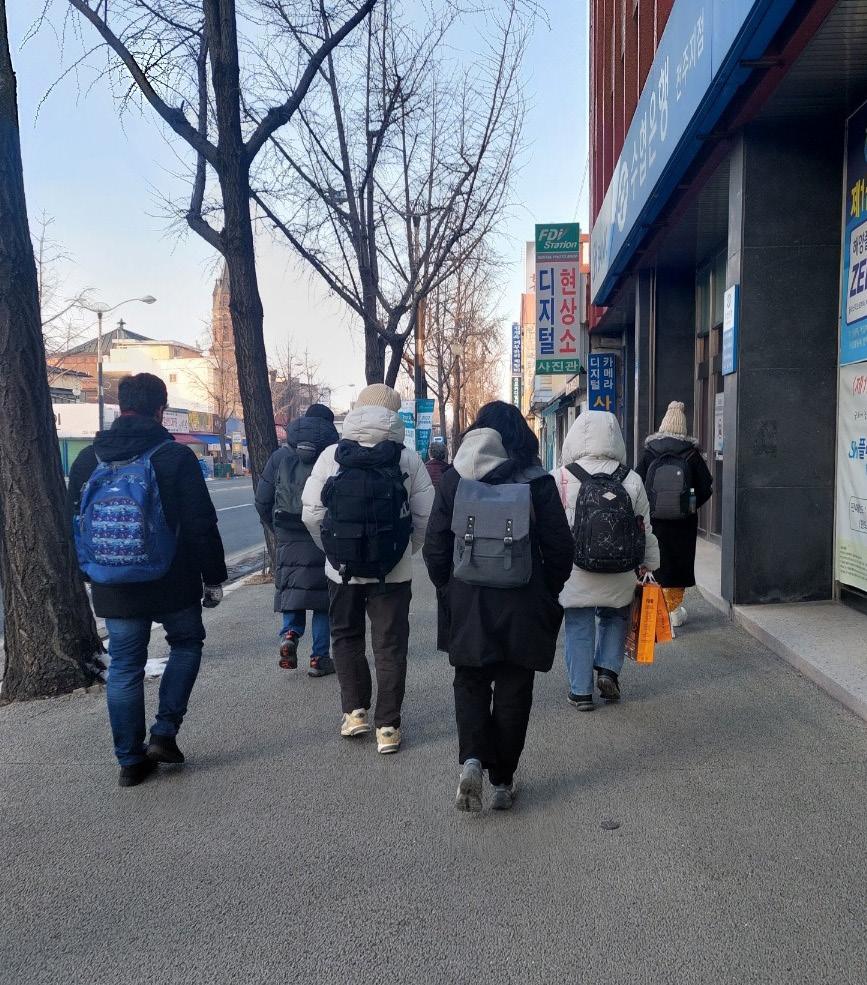
situations reflect deeper cultural dynamics that amplify the academic pressure. This situation may arise from the expectation of international students to be accepted and understood by local students. In contrast, local students often assume that international students must adapt to the local culture. When these expectations do not align, I think the notion of a “global university” remains merely a designation on paper because it solely focuses on admitting international students or offering Englishlanguage programs, but has yet to fully consider how to foster an inclusive culture within the campus.
The undergraduate level is crucial because it is a transitional phase of life where students are just beginning to learn how to live independently and build social networks in society. All this happens simultaneously for an international undergraduate student, especially in a foreign environment. Without sufficient support, social isolation can harm both mental health and academic performance. Therefore, universities hold a strategic role as educational institutions and as agents of social change. A university should not merely be a place to transfer knowledge but
also a space for cultivating new values, including openness to other cultures.
To achieve this, universities must actively cultivate the value of openness, especially at the undergraduate level. Because on this level, students learn how to socialize, shape their mindsets, and broaden their perspectives. When local undergraduate students experience crosscultural engagement on campus, they become far better prepared to embrace diversity at home and confidently navigate life abroad. At the same time, international students benefit from a more welcoming and inclusive environment, freeing them to focus entirely on their learning without the weight of social isolation.
“A university should not merely be a place to transfer knowledge but also a space for cultivating new values, including openness to other cultures.”
Furthermore, universities should create a support system for every facet of campus life, such as peer mentoring programs, multicultural extracurricular activities, and curricula that promote cross-national understanding. In this way, the responsibility to adapt extends beyond international students, but also encourages the entire campus community to cultivate greater inclusivity and openness. Only when all university members embrace diversity can it truly serve as a platform for global learning, not merely on paper but in everyday life. A university’s global reputation means little without the weight of global responsibility behind it.

The Author A. Ayuningsih is a graduate student seeking to express the concerns she observes in her surroundings. She hopes that her words may raise awareness and offer a meaningful contribution to the broader community and society in which she lives.

“
By Johanna Lezada
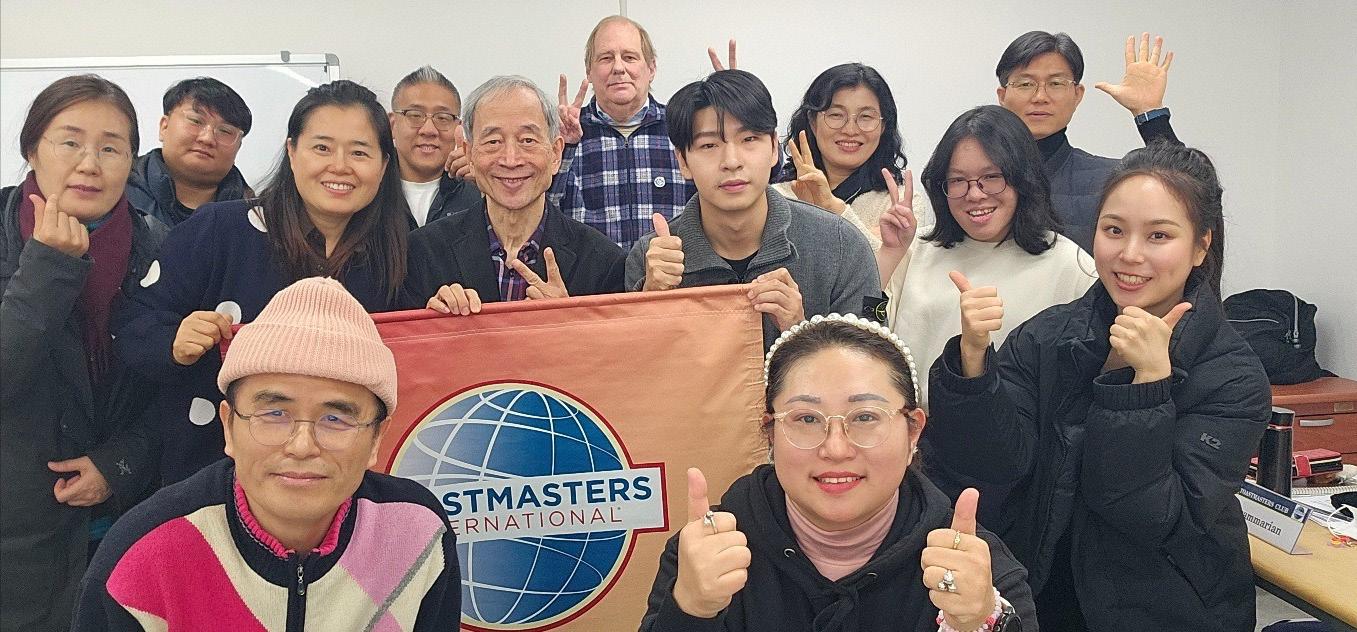
Back in October of 2020, I was a foreign university student in Korea recovering from a traumatic incident and barely had the appetite for anything. For all my life until then, I had never considered myself a leader nor a public speaker. All I knew was that I had things to say.
Then one day, my father introduced me to a public speaking club called Toastmasters.
At first, I thought it somehow involved bread, but I found no trace of bread at the scene. I didn’t know at all what it was about, so I kept quiet, observing how the meeting would go. The atmosphere did feel welcoming, and the members would toss casual comments and jabs at one another during
the meeting, loosening the tension I felt… until I instinctively raised my hand.
“You have a voice, Jo, use it!”
The Table Topics Master gave out a question I knew I could answer, and all I could think about was what I wanted to say and how this was my one chance to say it! My palms were sweaty, my head light, but the words poured out, and everyone listened regardless of the many uh’s, um’s and stutters that were interjected in between my words.
Since that day, I have realized the value of a Toastmasters club. Much like how the Gwangju News is a magazine that freely gives its pages to
aspiring writers and journalists, Toastmasters provides a platform for people who have things to say and shows them the art of how to say them concisely and passionately. It aims to provide a supportive and positive learning experience in which members are empowered to develop not only communication but leadership skills as well! I wanted to help incoming guests experience the same warmth I did when I first came and joined, so I took on my first officer role in 2022.
“My palms were sweaty, my head light, but the words poured out, and everyone listened...”
Even now as I’m writing this in 2025, that objective has never changed. Remembering the first time I gave a prepared speech, having to stand in front of multiple eyes staring at mine for more than two minutes, I think about everyone who still feels this way about public speaking. I still feel this way sometimes when having to speak in my second and third languages, Tagalog and Korean. I haven’t forgotten that nervousness, that fear of fumbling one’s words and people not understanding what you’re saying. We are all our own worst critics.
However, as the president of Gwangju Toastmasters, I aim for our club to lend aspiring speakers a helping hand in absolving their speaking fears by telling them that it’s okay to be nervous! It’s okay to feel shy, unprepared, and afraid. It’s okay to make mistakes and to slip with our words because it’s our responsibility to encourage everyone with positive, constructive feedback that they can use to improve on what form of communication is best suited to their personal needs. If I – who used to be a nervous, stuttering wreck – can become the professional host that I am now, then surely anyone can achieve full confidence in their public-speaking skills – whether they need it for presentations, job interviews, or event
hosting, all at their own pace of comfort. As I’ve told many guests in the past, public speaking isn’t just talking in front of an audience, it’s having a conversation with them, and encouraging communication by welcoming engagement, as well. Because communication is a two-way street, public speaking is also knowing how to speak to those who are listening to you. Therefore, you don’t need to complicate your sentences with fancy words or talk like a politician to get your point across.
In Toastmasters, if you have something to say, just say it! We’re all here to listen.


Every Saturday, 3:00–4:30 p.m., Gwangju International Center, 2F, Room 5
Find us on:
Facebook: Gwangju Toastmasters Club Websites: www.toastmasters.org www.district93.org
Phone: 010-7250-9130
Email: johanna.flez@gmail.com
* Korean Toastmasters meetings are held biweekly on Saturday at 1:00–2:30 p.m at the same venue.
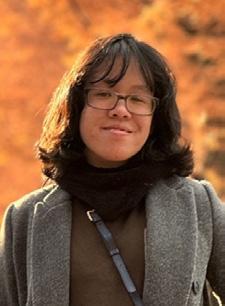
As a Filipino living in Gwangju, Johanna Lezada aims to stay in Korea by mastering the Korean language to give back to the city she has lived in since she was eleven years old. Presently, she is in her final semester at Nambu University, a devout worker at a Filipino Christian church in Hwasun, the president of Gwangju Toastmasters, and the volunteer layout editor for the Gwangju News.
By Chung Hyunhwa
Did you know there are more and more “fragrance-free zones” or “scent-free zones” being created in North American and European countries? This is because of the awareness of the potential and actual hazards of artificial fragrance or scents being overused, and an increase in those who are sensitive to these artificial fragrances. There is a technical term now to describe these symptoms: “artificial fragrance syndrome.” When a person with this syndrome is exposed to synthetic fragrance, they may experience symptoms such as headaches, migraines, skin irritation, brain fog and dizziness, gastrointestinal upset, respiratory issues, and more.
Sensitivity to fragrances varies for individuals for sure, but according to an Environmental Working Group’s study, some fragrances’ chemical ingredients may be linked to allergic reactions, endocrine disruption, respiratory and neurological issues, and even cancers. “Fragrance-free zones” or “scent-free zones” are being promoted especially for workplaces, schools, and healthcare settings to include everyone and to provide information about the benefits of a non-fragrance environment.
Fragrance is used everywhere nowadays. Restrooms and toilets are the most common places, but you can find fragrance literally anywhere, even in a coin laundry, a department store, or a retail shop. Besides perfumes and colognes, most cosmetics, hair products, soaps, detergents and clothes softeners, scented candles, and diffusers compete to attract the attention of customers –all because fragrance is generally considered to create an inviting and welcoming atmosphere.

Encountering the natural fragrance of orchids, roses, and jasmine and orange blossoms in nature is more than just pleasant – it’s moving, touching. The fragrance of these may add the finishing touches to the sweetest memories of trips with loved ones. However, it is a fact that natural ingredients to create “real” fragrance products are very limited and expensive. For instance, one kilogram of rose essential oil requires up to 10,000 kilograms of rose petals. Everyone wants fragrance, but the supply is always short, creating a need for artificial or synthetic fragrance to meet the fragrance demand.
While artificial fragrance is a broader term to include aroma chemicals produced from other technologies such as biochemistry – which are
considered to be more sustainable – synthetic fragrance is a specific term for what is mostly made chemically from petroleum or natural gas, and therefore, it is very convenient to produce and very cheap. Just like plastics, modern alchemists have made it possible to create as much fragrance as the market desires. As a result, we are now living in a world where fragrance is abundant, if not overabundant.
For the industry, synthetic fragrance was a welcomed innovation because it could replace natural fragrances that became unavailable, such as musk, which is now a banned ingredient. About 3,000 chemicals are now being used to create fragrances, and one product may contain over 200 chemicals under the single term “fragrance” or “perfume.” Manufacturers do not have to specify all the specific ingredients included in a fragrance because “trade secrets” are protected by laws.
Not all chemicals used to create fragrances are harmful, but not all the impacts of each ingredient have yet been clearly specified, so for safety, customer discretion is required. According to Ecostore in Australia, benzene derivatives and phthalates are the most harmful among the fragrance chemicals. Benzene has been prohibited by the International Fragrance Association because increased exposure to it is associated with a higher risk of cancer. Phthalates have not been banned by EU regulations yet because of their low risk when used in low concentrations, but there is ongoing debate since they also have the potential to disrupt hormone balances in the body.
While awareness of their dangers is slowly spreading, in reality, we are still surrounded by synthetic fragrance. So what should we do about it? Even if we pay attention to the labels of the products we buy, there are always potential risks in the presence of fragrance. Checking labels is still important to reduce the risks from hazardous chemicals such as benzene or phthalates. Another best practice is to buy from more trusted brands that prioritize the use of natural ingredients over
synthetic ones. Use natural essential oils from plants for fragrance, if you need to. There are also apps nowadays to verify the ingredients of cosmetics and fragrant products, so spend some time researching before purchasing a product if you want to avoid unsafe chemicals.
One more important reason to consider when giving thought to going non-fragrance is that these chemicals are volatile and contribute to greenhouse gases way up high. The weather nowadays is not the same as before. Some people deny the climate crisis and others acknowledge it but do not believe that humans can control the changes. I am committed to doing my part to overcome the climate crisis, and I hope to see more rapid development of technologies to take us back to the normal climate of 100 years ago.
The global temperature rise is proceeding more rapidly than we estimated even a few years ago, some scientists say, but I still think we can come up with solutions. Until we do, individuals should all do their part daily: recycling, reusing, minimizing energy use, going green as much as possible, and using more natural ingredients instead of synthetic products in daily life. Not using fragrance is also something we should do, not only for people with high sensitivity but also for the entire human race.

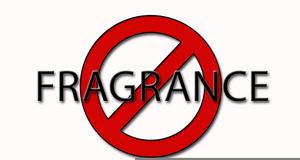
The Author
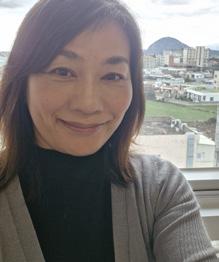
Chung Hyunhwa, a native of Gwangju, recently worked for a horticultural company. She led the international ecohike group Gwangju Hikers at the GIC in 2020 and 2021. Previously, she taught English at Yantai American School and Yantai Korean School in China and worked in school administration at Branksome Hall Asia in Jeju. She holds a master’s degree in TESOL from TCNJ in the U.S. and a license to teach Korean. She loves plants, birds, and repurposing items creatively.
By Saqib Sharif
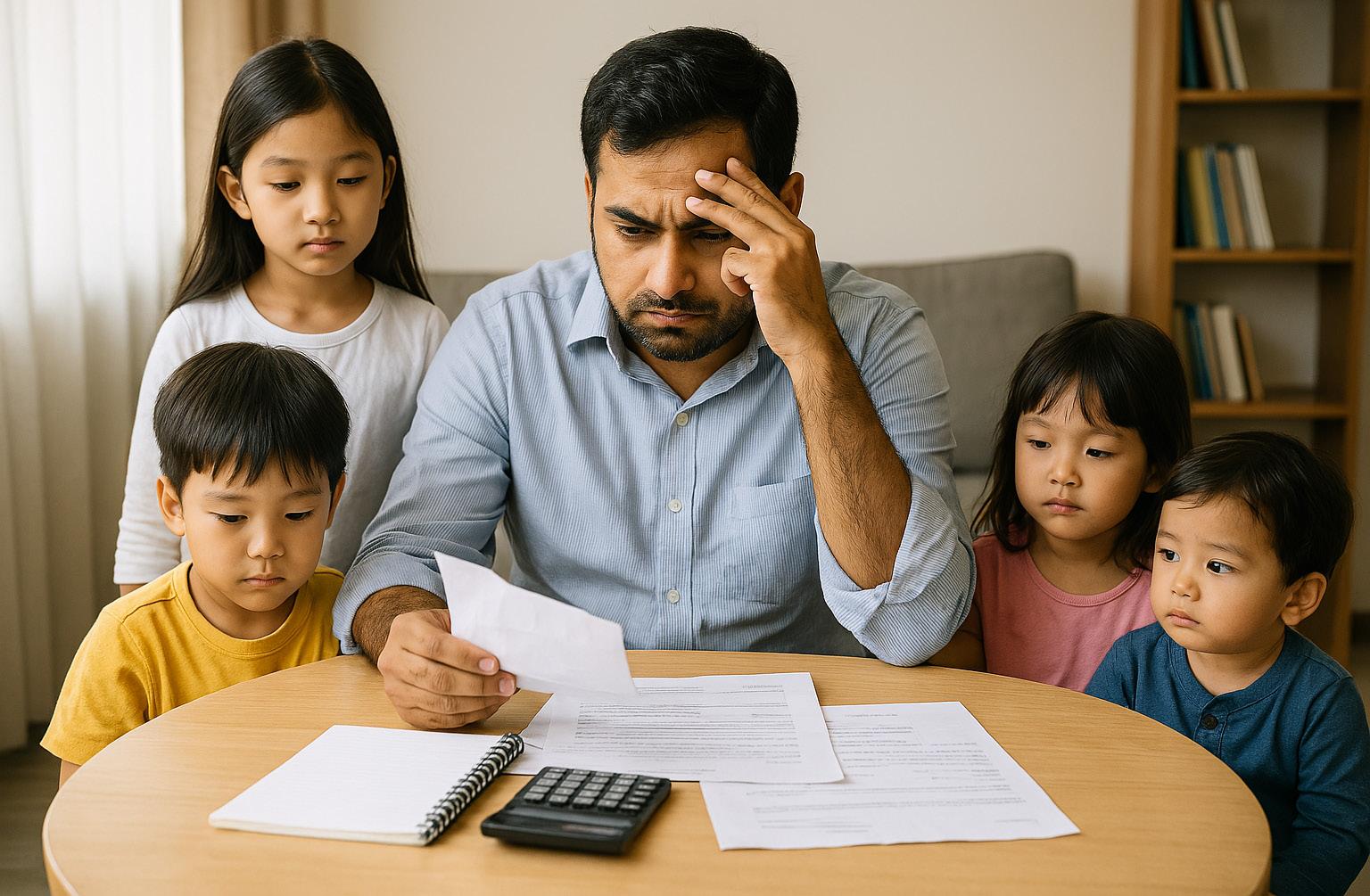
South Korea has long grappled with a declining birth rate, prompting the government to introduce various financial incentives to encourage larger families. These benefits include discounts on mortgage interest rates, subsidies for artificial insemination, and expanded childcare support for families with three or more children. Additionally, certain districts, such as those in Busan, have significantly increased birth bonuses, offering up to 10 million won for families with three or more children.
However, these benefits predominantly target Korean nationals, often excluding foreign residents. While some progress has been made,
such as Seoul extending childcare subsidies to all children from infancy to age five regardless of nationality, many foreign families remain ineligible for comprehensive support.
“Some landlords are hesitant to rent to families with multiple children.”
Consider the case of a foreign researcher who has lived in Korea for over a decade. As a singleincome father of four children, two of whom
were born in Korea and all attending government schools, he faces significant financial challenges. Despite a reasonable salary, the high cost of raising children in Korea strains his finances.
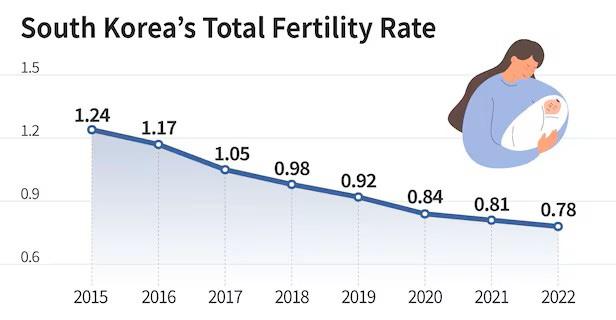
His situation is well-known among his Korean colleagues at two universities and his workplace, where he interacts daily with over 50 locals. Observing his struggles, some coworkers express reluctance to marry or have children, joking that they would never consider parenthood under such circumstances.
Beyond financial strains, he also encounters challenges in securing housing. Most Korean landlords are hesitant to rent to families with multiple children, fearing potential noise or property damage. This reluctance exacerbates the difficulties faced by larger families, particularly those of foreign nationals, in finding stable and suitable housing. While South Korea’s Housing Lease Protection Act offers certain rights to tenants, including foreigners, in practice, discrimination persists. The National Human Rights Commission of Korea has recognized that policies excluding children from certain establishments are discriminatory, highlighting a broader societal issue of acceptance toward families with children.
This scenario illustrates a broader issue: the exclusion of foreign residents from family benefit schemes may inadvertently discourage the local population from expanding their families. When Koreans witness their foreign colleagues
struggling without adequate support, it reinforces the perception that raising multiple children is financially untenable.
To address this, the government should consider extending family benefits to include foreign residents with three or more children, especially those whose children were born in Korea. Such inclusivity would not only alleviate the financial burdens on these families but also send a positive message to the broader community about the support available for larger families. By ensuring that all families, regardless of nationality, receive adequate support, South Korea can take a significant step toward reversing its low birth rate trend.

Sources
Al Jazeera. (2023, April 12). South Korea has so few babies it is offering new parents $10,500. https://www.aljazeera. com/news/2023/4/12/south-korea-splashes-the-cashin-scramble-to-fix-fertility-crisis Al Jazeera
Child Benefit. (2025, February 3). In Wikipedia. https:// en.wikipedia.org/wiki/Child_benefit
The Korea Times. (2025, March 11). Korea unveils additional steps to boost birthrate. https://koreatimes.co.kr/www/ nation/2025/04/281_393926.htmlKorea Times
The Korea Times. (2025, February 26). Major conglomerates encourage employees to have babies. https://www. koreatimes.co.kr/www.tech/2025/03/129_392991. htmlKorea Times=
National Human Rights Commission of Korea. (2024, January 25). Child with Disabilities Denied Education at international school, Commission Seeks Justice https://www.humanrights.go.kr/eng/board/read?board ManagementNo=7003&boardNo=7609793&menu Level=&menuNo=&page=2&searchCategory=& searchType=&searchWord=Human Rights Commission
The Author
Saqib Sharif is a Pakistani national, he earned his PhD from Chonnam National University in February 2024. Currently, he serves as a senior researcher at Shinsung Tech in Gwangju.
By Park Nahm-Sheik
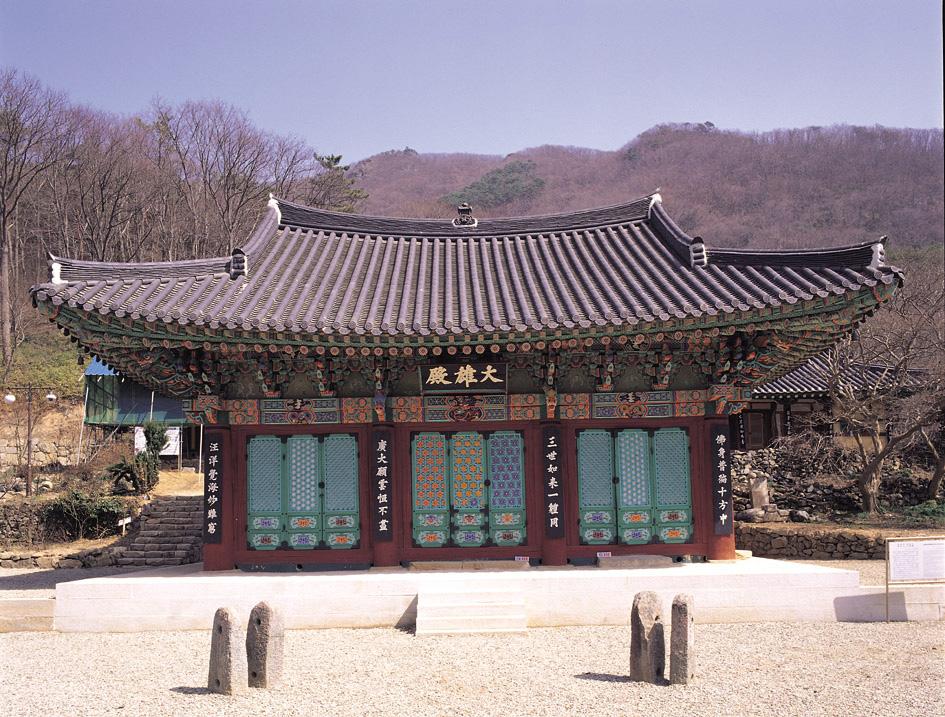
Gwangju-Jeonnam is blessed with several big-name Buddhist temples. To begin with, the region happened to be where Buddhism had its first encounter with this country. The faith came to Korea via the port of Beopseong-po in Yeonggwang County around 384 C.E. Parenthetically, both Bulgap Temple (불갑사) and Beopseong-po (법성포) are pregnant with suggestive indications. “Bulgap Temple” clearly says that it is the “top Buddhist temple” of Korea. “Beopseong-po” highlights the pride of place afforded it as the port hallowed in the annals of Korean Buddhism, as “beop,” “seong,” and “po” here reference “Buddhism,” “holy,” and “port,” respectively.
Legend has it that Maranatha, a Buddhist missionary of Indian heritage, is said to have first set foot in southwestern Korea by way of China. He must have braved thorny trails and fierce waterways ad infinitum all the way from Lumbini in the upper northwestern corner of the Indian subcontinent to the upper northeastern corner of the Asian continent. Originating in the ancient Aramaic tongue, “Maranatha” means something like “The Lord has come!” This expression is said to appear in the Christian Bible in Corinthians
(16:22) and also in the Gospel According to John (22:20). This apparently has to do with the shared origins of Buddhism and Christianity.
Gwangju-Jeonnam boasts several other wellknown temples. Hwaeom Temple (화엄사) and Yeongok Temple (연곡사) are particularly prominent. The Mt. Jiri National Park in Gurye is home to both of these big-name temples. High Priest Uisang-daesa is thought to have had 80 volumes of Hwaeom-gyeong (the Diamond Sutra) stone-engraved for permanent storage at Hwaeom Temple. The temple itself was built in the middle of the seventh century as the lead temple, so to speak, for the 19th Jogyejong District to oversee all the temples in and around Mt. Jiri. Hwaeom Temple was constructed at royal behest with overall management charged to High Priest Yeongi-josa. In 875, it was expanded with High Priest Doseon-guksa at the helm.
Gakhwang-jeon (realize-sovereign-hall), a prominent structure in Hwaeom Temple, is complemented by an impressive stone lantern (National Treasure No. 12). Presumably dating back to the Unified Silla Period, it stands 6.4 meters tall and measures 2.8 meters across. This stationary lantern known as Gwangmyeongdeung (the illumination lamp) symbolizes the light radiating from the Buddha. Slightly upward of Gakhwang-jeon is Sasajasang (sculptured pride of four lions; National Treasure No. 300). In the den of these lions is the Rev. High Priest Yeongi-josa on his knees reverently holding aloft a cup of green tea for his mother, an unmistakable icon of true filial piety.
Also in Mt. Jiri National Park is Yeongok Temple, another monumental Buddhist temple dating
from the Silla-Baekje era. It is interesting that the Chinese characters employed for “Yeongoksa” apparently speak to the temple having hosted an abundance of swallows. Lore has it that large flocks of swallows made their home there, giving rise to the name of the temple, which obviously reminds us of a valley chock full of swallows. Legend has it that, built around the 22nd year of Baekje King Seongwang (544 C.E.), it served as a place of worship and prayer for Zen meditation practitioners. This temple was the brainchild of Yeongi-josa, who is said to have hailed from Gandhara, India. On the temple premises are Dongseung Stone Pagoda (National Treasure No. 132) and Bukseung Stone Pagoda (National Treasure No. 133). By the way, the “jiri” of “Mt. Jiri” derives from “duryu” in proto-Korean of the early Goguryeo period and means “very tall.” Both Mt. Baekdu and Mt. Jiri are thus supposed to be very tall mountains, according to their etymological roots.
Mt. Jiri is also remembered as a grim reaper of a mountain that has become permanently etched into the recent history of Korea. Indelibly engraved in our collective memory is its place as a major setting for eerie blood-drenched confrontations between the two Koreas and their ideologies from the late 1940s through the 1950s and into the early 1960s. Despite this tragic history, Mt. Jiri ranks high on the list of the most acclaimed mountains in the country. It certainly is awesome and even venerable as mountains go.
Unju Temple (운주사; cloud-riding-temple) is on Mt. Cheonbul (천불산; thousand-Buddhamountain) in Doam-myeon of Hwasun County. Some thousand stone images of the Buddha are supposedly scattered over the mountain. Reclining Buddhas, as most of them are, afford visitors a rare sight to behold. It is amazing how our ancestors so long ago could possibly imagine putting up such a mind-boggling legion of sculptured works of art for such an out-of-theway place.
For those who especially crave a quiet getaway, Hyang-il Hermitage (향일암) in Yeosu is a gem of a retreat. As can be gathered from the name,
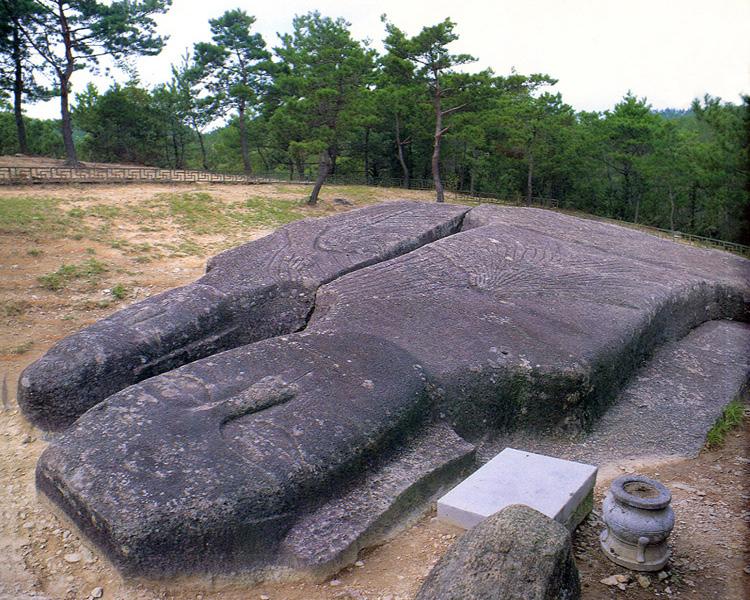
it is a peaceful seaside hermitage, where one can quietly enjoy viewing the sun as it rises above the horizon smiling down upon our humble planet. It is a breathtaking lookout point. A peaceful temple stay here may be prescribed for a patient recuperating from a health issue. It makes an ideal resort for rest and recreation and overall rehabilitation, especially for those facing an extended uphill battle with a condition that is not easy to cope with.
Let me close this essay by thanking a couple of friends, who came to my aid every time I was in need for this article. For one thing, they have brainstormed with me providing priceless tips about the temples featured in this narrative. Yang Inmo, a native of Gurye, came to my assistance whenever I was in need of in-depth knowledge about Hwaeom and Yeongok Temples. For another, Park Sangyong complemented my meager understanding about Unju Temple and Mt. Cheonbul. He is well versed in the folklore of relevance as a former journalist from Hwasun and based in Gwangju.

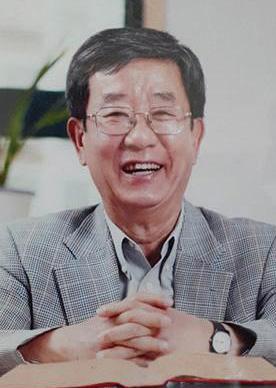
Park Nahm-Sheik is a native of Gwangju. After graduating from Chonnam National University, he went on to receive a master’s degree at the University of Hawaii and a PhD (applied linguistics) at Georgetown University, both in the U.S. Upon completing an illustrious career at Seoul National University, Prof. Park served as president of the International Graduate School of English.
Stoner
By John Edward Williams
Reviewed by Michael Attard
292 Pages, New York Review Books, 2005 (Original 1965)
ISBN: 10:1590171993
The story Stoner, by John Edward Williams (1922–1994), is fiction but draws from the author’s own life. A tale of humble beginnings from dirt poor farming, flowing into the world of academia, social acceptance, and success. Yet, while our protagonist finds his calling and becomes an unwavering crusader for the cultural glory of English literature and the lofty standards of erudition, his private life is asunder with misguided affection, weak response, and meek resignation.
William Stoner was born in 1891 on a small farm in Missouri. His human failings are balanced by a strength of character and independence. When a professor and mentor asks about his plans for after graduation, Stoner simply and quickly responds, “I don’t know.” But when the professor inquires further pertaining to a return to the farm, what immediately follows is a “No Sir,” said with such a decisiveness that his own voice surprised him.
America had become involved in the European war, and young men were rushing to the military. Stoner decides not to go to war, well aware that he is disappointing his friends. The author masterfully elucidates the emotional depth of the moment. “He felt no guilt for his decision … but he was aware of the looks that he received … and of the thin edge of respect that showed through his students’ conventional behavior toward him.”
The quality of the writing makes this a great book. With precision and accuracy on every page, the reader finds oneself at the center of Stoner’s
world. When he first meets his wife-to-be, Edith Bostwick, the writing captures inescapably the pulse of the young Stoner’s metaphysical heart. “Stoner paused in the doorway, caught by his vision of the young woman…. Stoner was assailed by a consciousness of his own heavy clumsiness … he felt the gaze of the young woman brush warmly across his face.” When referring to Edith’s large pale blue eyes, “he seemed drawn out of himself, into a mystery that he could not apprehend.”
Stoner and Edith marry. “Within a month, he knew that the marriage was a failure; within a year he stopped hoping that it would improve.” But the author does not leave the discourse at that. Rather, using language that literally emanates from under the bed sheets, he shares with the reader Stoner’s animal instincts and Edith’s sense of violation. “Sometimes at night … his resolve and knowledge crumbled … and he moved upon her … performed his love as quickly as he could, hating himself for his haste, and regretting his passion.”
Edith wages a personal and not so secretive war against Stoner. As if one challenging foe was not enough, there is a second antagonist in the person of Professor Lomax, who eventually becomes the chairman of the English department. The duplicitous Lomax becomes an epitome of scholastic dishonesty, an embodiment of moral corruption and dishonor. Stoner and Lomax lock horns over an unqualified student whom Lomax, for an undisclosed reason, wants to push through
the system. Stoner, for his part, will not give the student a passing grade. Eventually, Lomax gets his chance to ruin Stoner.
We then meet the stoical Stoner. Morals of the time did not allow a married male professor to enjoy an affair with a younger female colleague. Yet, inadvertently, this is exactly where Stoner found himself. “In his extreme youth, Stoner had thought of love as an absolute state of being … in his maturity, he had decided it was the heaven of false religion…. Now in his middle age, he began to know that it was neither a state of grace nor an illusion; he saw it as a human act of becoming.”
“With precision and accuracy on every page, the reader finds oneself at the center of Stoner’s world.”
Nevertheless, Lomax had him: “Stoner knew somewhere within the numbness that grew from a small center of his being, that a part of his life was over.” Stoner and his lover, Katherine, both impassively understood their situation. Saying farewell was necessary to avoid the destruction of their selves. Stoner says, “If I gave it up, just walked out – you would go with me, wouldn’t you?”
“Yes,” she said.
“But you know I won’t do that, don’t you?”
“Yes, I know.”
Essentially the story is complete at this point, but the author tells us more. This does not imply that the author is filling pages. Rather, there is a wrapping up of one’s affairs. We encounter a change in Stoner’s temperament, more quarrelsome than before, but still “the knowledge of common misery touched him and changed him … and a quiet sadness for the common plight was never far beneath any moment of his living.” He continues to live, acquiescent to Edith’s demands and his daughter Grace’s poor life choices.

Stoner becomes ill. “He had no wish to die; but there were moments … when he looked forward impatiently.”
Interestingly, Williams’ third novel, Stoner, when first published in 1965, was not a commercial success. Less than 2,000 hardcover copies were sold. But it was reissued in 2005 to widespread critical acclaim.

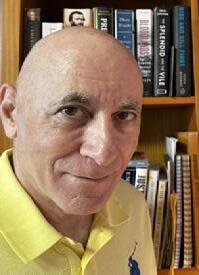
Michael Attard is a Canadian citizen but has lived in Gwangju for over twenty years. He has taught English as a second language in academies and within the public school system. He is officially retired and spends time reading, writing, hiking, and spending time with friends.
By Anne Nguyen
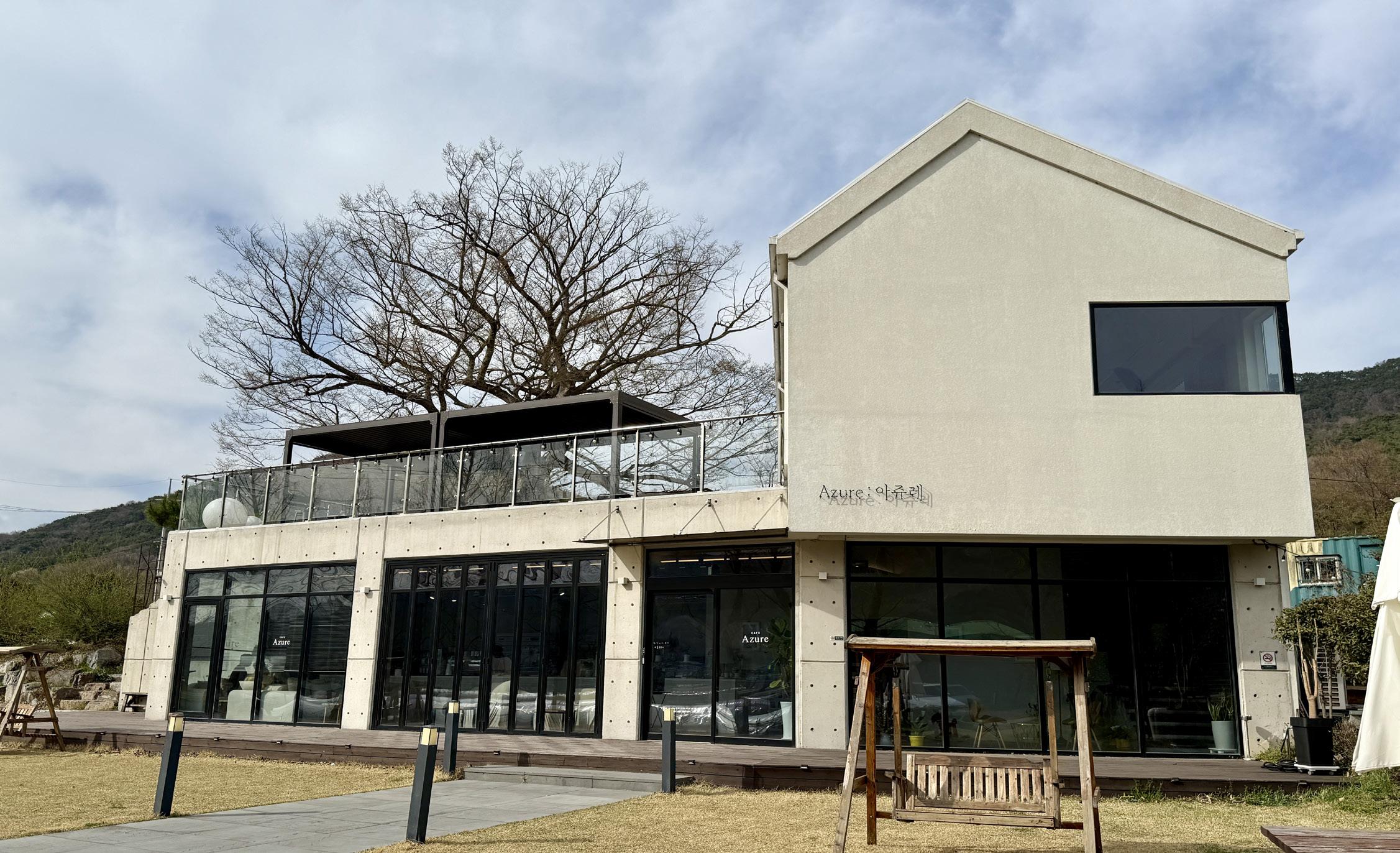
On the quiet outskirts of Mujeong-myeon, just ahead of the Mujeong Industrial Complex, Azure Café offers a scenic and serene stop for coffee lovers. Surrounded by pine tree nurseries and open space, it’s quiet, spacious, and thoughtfully designed for those looking to step away from the city without going far. Whether you are craving a slower pace, planning a weekend drive from Gwangju, or searching for a spot to enjoy coffee with your pet, this café brings together calm scenery, cozy interiors, and genuine hospitality.
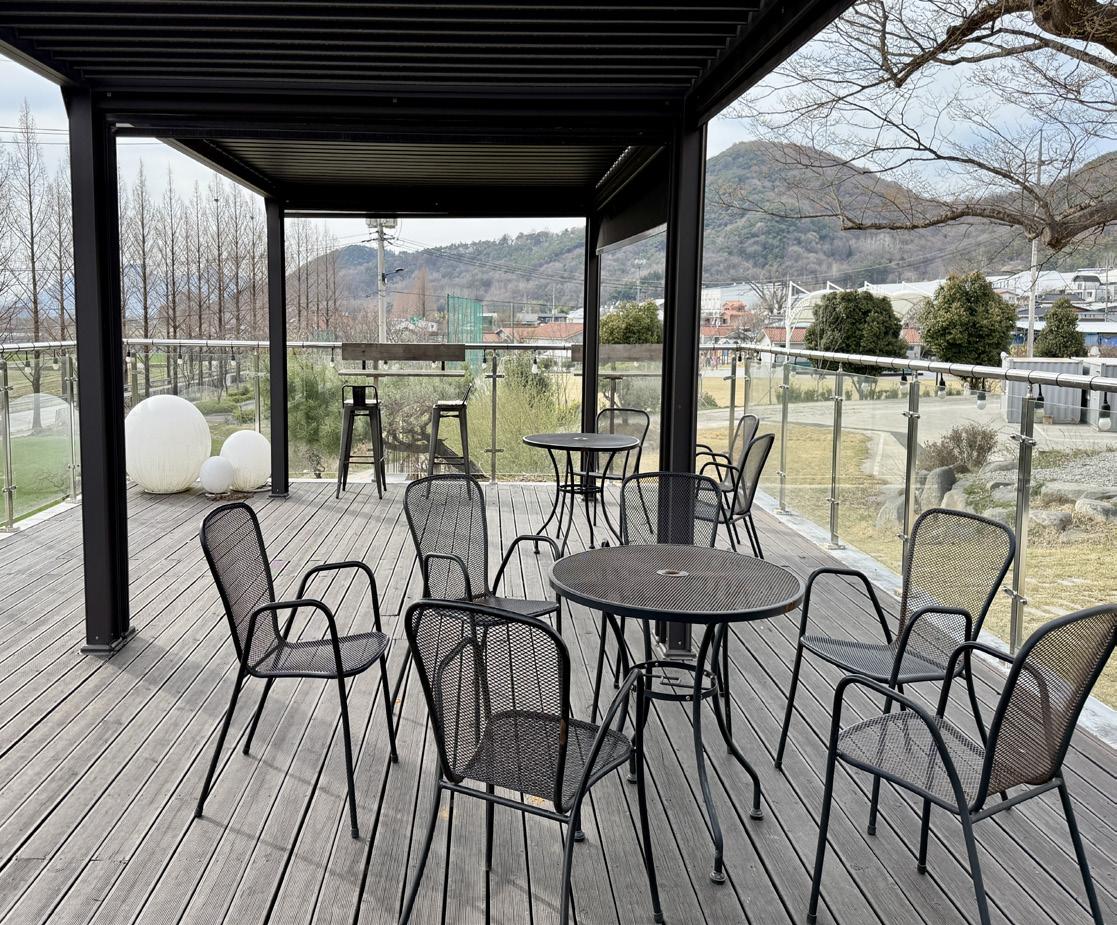
Azure Café stands alone in its area, which adds to the sense of calm. The moment you arrive, the fresh scent of the Damyang countryside greets you. With a wide private parking lot and open grounds, it already feels like a break from the everyday. Inside, the space is spread across two floors. On the first floor, soft sofas are placed near large windows that overlook a well-kept lawn. Although most seats were taken when I arrived, the space remained peaceful. Later in the afternoon, when the café emptied slightly, the golden light made everything feel even more inviting.
The second floor offers even more space, with high ceilings and seating for both small and large groups. There is also an outdoor terrace with views of the surrounding trees and lawn, which is perfect for enjoying coffee on a clear day.
Azure Café has a menu that works well for anyone who enjoys good coffee and something sweet on the side. You will find familiar drinks like iced Americanos, and the staff even offers an extra shot of espresso if you want your coffee stronger. The flavor is smooth with a slight tang, making it easy to drink and refreshing at the same time.
The dessert section includes a nice variety of pastries. Among them, the mocha salt bread stood out the most. It had a crispy, golden outside and a soft, buttery inside. There were many other baked items on display that looked just as delicious. Even though I couldn’t try them all during my visit, everything looked fresh and carefully made. If you enjoy pastries with your coffee, this café is worth visiting more than once.
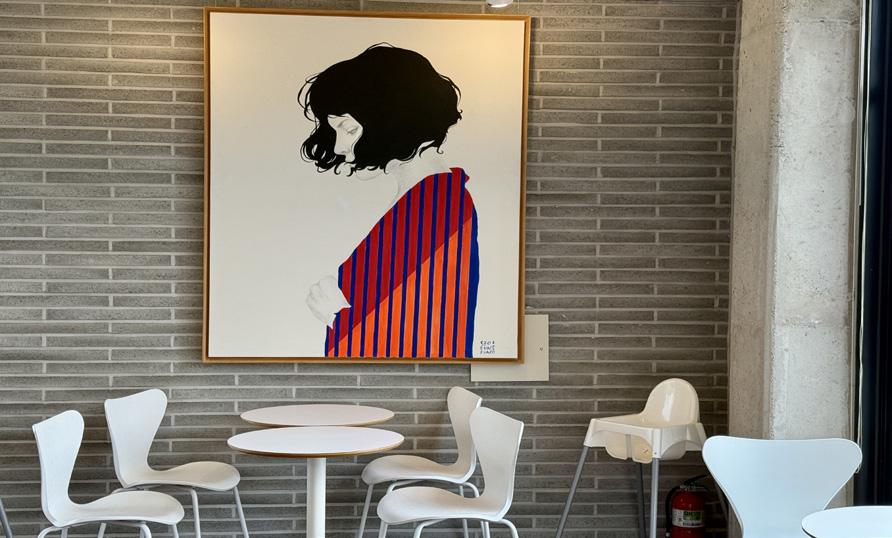
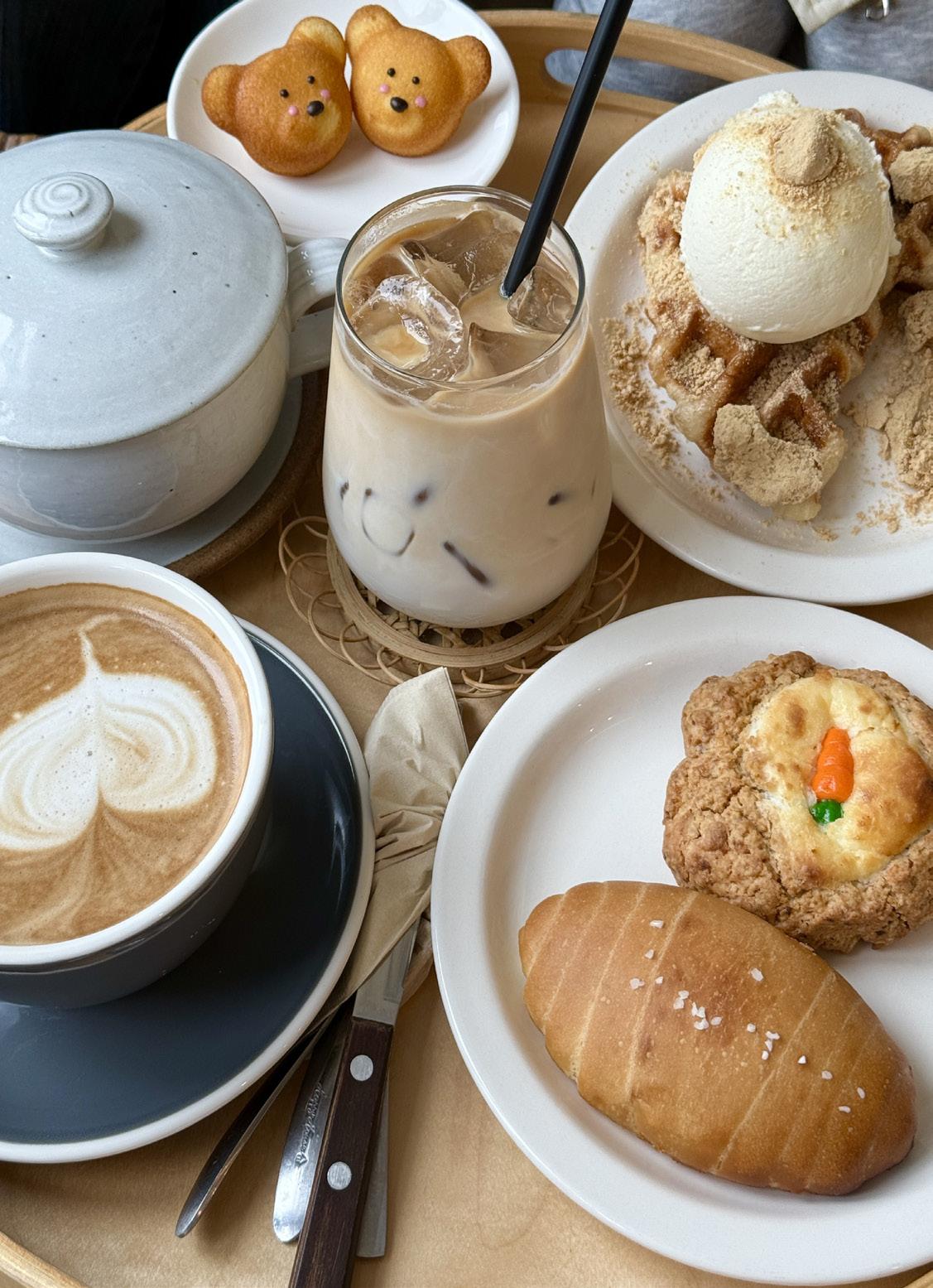
Address: 565 Mujeong-ro, Mujeong-myeon, Damyang-gun, Jeollanam-do
Hours: 10:00 a.m. – 6:00 p.m. (Closed on Mondays)
Amenities: Free parking, pet-friendly (outdoor lawn & terrace), baby chairs available, outdoor seating, group seating (4–6 people).

by Anne Nguyen
Author
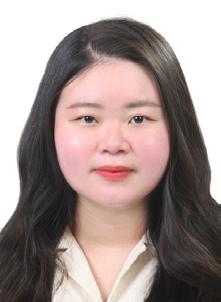
Anh Nguyen (Anne) has been living in Gwangju for five years studying journalism and communication at Chosun University. She fell in love with the city’s beautiful views, rich history, diverse culture, and delicious food. Her goal is to share her love for Gwangju and introduce its stunning natural scenery and attractions to everyone.

By Maryam Ali
Nana Bangkok is a Thai restaurant chain based in Korea. I was recommended this restaurant by a friend who kept ordering from it on a food delivery app. We visited in person to see if the taste carried over to the restaurant. As a restaurant chain, there are four Nana Bangkok dotted around Gwangju with one located in Seo-gu, another situated in Dong-gu and two located in Gwangsan-gu. For this article, I decided to visit the Seo-gu location, as it is the headquarters in Gwangju.
The first thing I noticed while visiting the restaurant was the big elephant head protruding from the outer wall to the left of the entrance. The restaurant is decorated in a cohesive minimalistic style, and I was able to take in the atmosphere of the restaurant. I initially visited Nana Bangkok with my friend. When entering the restaurant, we were asked the number of people in our party and directed to a table. I used the tablet on the table to read the menu and order a meal. I selected the lemon chicken, beef rice noodles, garlic shrimp fried rice, spring rolls, and a grapefruit ade.
The wait time in the restaurant wasn’t long during my first visit. However, since the visit for this article, I have experienced having to wait.
The server politely notified me of the expected wait time. The restaurant has a system where you can input a phone number into a machine to know your number in the queue. The ambiance of the restaurant was bright and the music playlist was pleasant. The staff were friendly from the beginning and promptly cleared tables after customers left when the restaurant wasn’t exceedingly busy.
When it comes to the meal, I loved the garlic shrimp fried rice. I believe it’s the standout dish on the menu. The beef rice noodles and lemon chicken were enjoyable. For the side dishes, the vegetable spring roll was delicious. All the dishes had a fantastic taste. Lastly, I found the grapefruit drink satiating, but that might be due to my propensity for grapefruit-flavored drinks in Korea.
The main highlight of this restaurant as I’ve mentioned is the fried rice. At the restaurant, there is a wide variety of drinks that look appetizing and optional herbs to fragrance the meals. The restaurant offers menu sets recommended for two, three, and four people. They allow customers to try a variety of meals in a single visit.
To verify whether I could stand behind the restaurant, I ordered from the establishment using the delivery app Baemin (배달의민족), a popular food delivery app in South Korea. To find the restaurant, I typed in "Nana Bangkok" (나나방콕) in Hangeul as it is easier to find the branch this way. My closest branch was the Dongmyeong-dong branch.
When ordering from the delivery app, there is a slight difference in the drinks menu. Only soft drinks like Cola, Fanta, Pepsi, Sprite, and canned Thai milk teas are offered. The minimum order from the restaurant for delivery is 20,000 won.
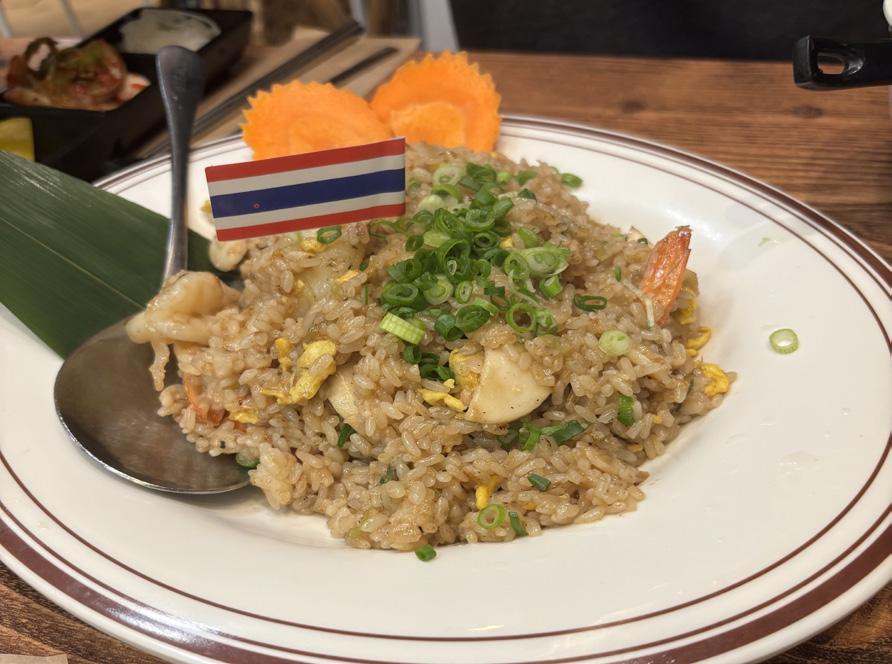
The meal arrived piping hot, but this is my personal experience. I can confirm that the Garlic Shrimp Fried Rice tasted just as good delivered as it did in the restaurant. The portions were sufficient for one person. I was able to try more side dishes and the customary side of pickled onions. I particularly savored the Tteotmankung, a Thai-style fried shrimp dish and enjoyed it with the sweet chilli dipping sauce.
Of course. If you like Thai food and you’re around Gwangju, I recommend that you try Nana Bangkok whether in person or through delivery. Since this review, I’ve personally ordered from the restaurant again and been to the branch at least twice, and each visit was as satisfying as the first.

Nana Bangkok Gwangju Sangmu
Headquarters
Open: Monday to Sunday, 11:30 a.m. to 9:30 p.m.
Address: 180 Sangmu Jayu-ro, Seo-gu, Gwangju (Chipyeong-dong) 1st floor
Website: https://nanabangkok.co.kr/ Phone: 0507-1349-7501
Nana Bangkok Gwangju Suwan Branch
Open: Monday to Sunday, 11:30 a.m. to 9:30 p.m.
Address: 17 Suwan-ro 73-beon-gil, Gwangsangu, Gwangju (Suwan-dong) 1st floor
Website: https://nanabangkok.co.kr/ Phone: 0507-1369-1112
Nana Bangkok Dongmyeong Branch
Open: Monday to Sunday, 11:30 a.m. to 9:30 p.m.
Address: 63 Dongmyeong-dong, Dong-gu, Gwangju, 1st floor
Website: https://nanabangkok.co.kr/ Phone: 062-236-2025
Nana Bangkok Gwangju Cheomdan Branch
Open: Monday to Sunday, 11:30 a.m. to 9:30 p.m.
Address: 19 Cheomdan-jungang-ro 116-beongil, Gwangsan-gu, Gwangju (Wolgye-dong) 1st floor
Website: https://nanabangkok.co.kr/ Phone: 0507-1357-5762

The Author Maryam Ali is currently based in Gwangju. Originally from London, she took the plunge to live abroad and share her experiences in a blog. As a budding journalist, she expresses her fascination with culture, aspiring to understand the world around her. Website: https://sites.google.com/view/maryamaliportfolio/homepage
By Zhang Jiuzhou (Julius)

The Kia Tigers’ bullpen crumbled spectacularly on May 7 in a game against the Kiwoom Heroes at Gocheok Sky Dome. Despite holding a comfortable seven-run lead heading into the eighth inning, the Tigers allowed an unthinkable comeback, eventually losing 11–10. The collapse saw Kia’s relievers give up eight runs in the bottom
of the eighth, raising fresh concerns about the stability of their bullpen.
Kia’s bullpen currently holds the highest ERA in the KBO, a glaring issue that threatens their chances of winning. Compared to last year, the Tigers’ relief pitching has undeniably weakened. Key reliever Jang Hyun-sik left for the LG Twins, while Kwak Do-gyu’s season was cut short by elbow surgery. Additionally, Im Gi-yeong and Yoon Young-cheol continue to struggle, and Cho Sang-woo’s performances remain inconsistent. With Hwang Dong-ha transitioning to the starting rotation, the bullpen’s depth has taken a noticeable hit.
There is optimism that the eventual return of Lee Eui-lee might allow Hwang Dong-ha to revert back to the bullpen, restoring some strength to the relief unit. However, recent news has delayed that hope. On May 8, Hwang Dong-ha was involved in a traffic accident while crossing a crosswalk in Incheon, suffering a back injury that is expected to sideline him for over six weeks.
Hwang Dong-ha joined the Kia Tigers as a second-round pick (65th overall) in the 2022 KBO Rookie Draft. He debuted on the first team in 2023, making 13 appearances and reaching a top speed of 147 km/h on his fastball. This season, he has pitched in 13 games, recording a 1–2 record. His steady improvement had been a bright spot for Kia, making his absence a significant blow.
Off the diamond, the Kia Tigers launched a special collaboration with Teenieping to celebrate
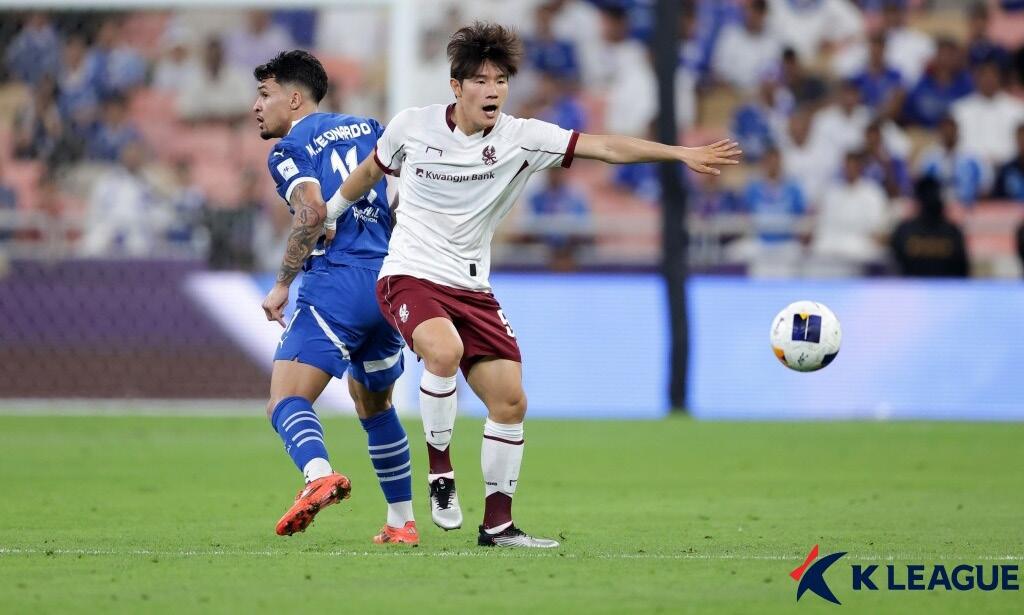
Children’s Day, debuting limited-edition uniforms that became an instant hit with fans. Teeniepings, beloved animated characters among children, were part of the design. The unique jerseys featured playful additions to the players’ names, adding “-ping” as a suffix. Particularly notable was foreign player Patrick Wisdom, who, due to his Korean nickname being “Baek Ji-hae (백지혜),” wore a jersey labeled “Ji-hae Ping (지혜핑),” drawing delighted reactions from fans.
Gwangju FC’s remarkable journey in the 2024–2025 AFC Champions League Elite (ACLE) came to a shattering end after a 7–0 defeat to Al Hilal in the quarterfinals. Despite the disappointing conclusion, Gwangju’s debut in the tournament was nothing short of miraculous, becoming the only K League team to reach the Round of 16.
The clash against Al Hilal was seen as a classic David versus Goliath scenario. Experts predicted a lopsided affair, given the vast disparity in squad value and international experience. Al Hilal, often regarded as not only a dominant force in Asian football but also competitive enough for
Europe’s major leagues, came into the match heavily favored.
Yet, Gwangju FC defied expectations by refusing to employ a defensive “park-the-bus” strategy. Instead, they showcased their own brand of football, opting for an aggressive approach against Asia’s strongest side. Though the match ended in a lopsided 7–0 scoreline, Gwangju’s willingness to challenge Al Hilal head-on earned them respect from fans and pundits alike. It was a bold gamble that didn’t pay off, but it highlighted Gwangju’s fearless spirit. Their tenacity in the face of overwhelming odds left a lasting impression, exemplifying the raw beauty of competitive football.
Gwangju FC head coach Lee Jung-hyo has long been known for his charismatic and fearless leadership style, a trait that has garnered him strong support from fans. However, his intense sideline demeanor recently came under criticism after a controversial incident during the Children’s Day match against Gimcheon Sangmu.
As the first half concluded, Lee, visibly frustrated, marched onto the field and loudly berated Oh Huseong, who had scored earlier in the match. The incident escalated when Lee was seen pushing
the player, a moment that drew attention not just for its intensity but because it took place in front of a crowd filled with young fans celebrating Children’s Day.
While fiery exchanges between coaches and players are not uncommon in football, the setting and timing of this confrontation sparked widespread debate. Many questioned the appropriateness of such public admonishment, particularly during a family-oriented event. Known for his assertive coaching style, Lee is now facing calls to find a more suitable way to express his passion and motivate his squad moving forward.
Despite the recent criticism, Lee’s commitment to pushing Gwangju FC to new heights remains unquestioned. As the team regroups after their ACL exit, Lee’s leadership will undoubtedly continue to shape their journey, albeit with perhaps a more measured approach.
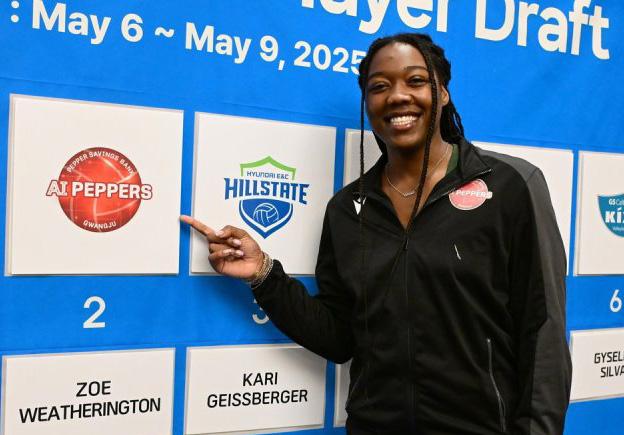
power have already made her a standout. Born in 2001, she has played professionally in Greece, the United States, and Puerto Rico. Primarily an opposite spiker, Weatherington is also capable of playing as an outside hitter.
Wearing the AI Peppers jersey for the first time, Weatherington expressed her excitement: “It’s an honor to be chosen among so many talented players. I believe hard work pays off.” When asked about her expectations for the V-League, she added, “I’m looking forward to meeting great people. I understand the training in Korea is rigorous and demanding, and I can’t wait to push myself to perform well.”
Head coach Chang So-yun praised Weatherington’s abilities, highlighting her powerful strikes and exceptional blocking skills. “Her strength is undeniable. Although she is not the tallest, her jumping ability, long wingspan, and high contact point make her a perfect fit for our style of play,” Chang remarked.
In another strategic move, the AI Peppers secured experienced outside hitter Ko Ye-rim from the free agent market. Having been drafted by Hi-Pass in the 2013–2014 season, Ko also played for IBK and Hyundai E&C. Coach Chang emphasized Ko’s balance in both offense and defense stating, “We expect her to be a cornerstone in our serve reception and a critical connection on the court.”
Ko Ye-rim expressed her excitement about joining the AI Peppers, citing trust in Coach Chang as her reason for signing. “I didn’t hesitate to join because I trust Coach Chang completely. I’m eager to show a better version of myself with this team,” she said.

On May 9, the AI Peppers made a significant move in the 2025 V-League Women’s Foreign Player Draft, selecting Zoe Weatherington with the second overall pick. Standing 184 cm tall, Weatherington may not be the tallest among foreign players, but her athletic prowess and raw
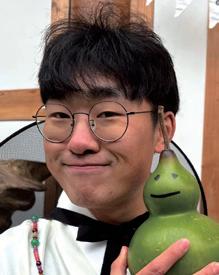
The Author Zhang Jiuzhou (Julius) is from Harbin, China. He began writing in 2022 and has contributed to the Chinese media in Gwangju. He concurrently serves at a sports data company. He is pursuing a master’s degree in media and communications and is responsible for the Chinese Students Association at Chonnam National University.
By Zhang Jiuzhou (Julius)
After a challenging yet rewarding season, AI Peppers’ star foreign player Taylor Fricano has returned to her home in Switzerland for the off-season break. Despite not being selected at the start of the season due to an injury, Fricano joined the team mid-season as a replacement and quickly became a new icon in the city of Gwangju. On the court, she led her teammates to fight for victories, while off the court, she showered her fans with affection, even delaying the team bus to fulfill fan requests. As a foreign player who has worked hard and thrived in Gwangju, Fricano is undoubtedly someone worth getting to know better.
Although the team aimed for a playoff spot and even held mid-table standings at one point, the AI Peppers ultimately ended the 2024–2025 season at the bottom of the rankings, continuing their unfortunate streak starting from their formation. Reflecting on the season, Fricano remarked, “I could have adapted to the Korean League faster and performed better. But it was still an amazing season, and we made significant progress. Sometimes, in crucial moments, we got too nervous and missed opportunities. But we are still a young team, and there’s a long way to go.”
Having played in multiple countries throughout her career, this was Fricano’s first experience competing in Asia. “The volleyball style in Korea is very different from what I’m used to in the United States,” she explained. “The coach emphasizes different things on the court. And with the language barrier, it was challenging to build quick chemistry with my teammates. But it was a truly interesting experience, one I will cherish.”

On the court, Fricano was a constant source of encouragement, always keeping her teammates’ spirits high. “Even when we struggle and give up points, I hope the girls can forget those mistakes and focus on the next play,” she said confidently.
Fricano had initially entered the KOVO foreign draft before the season but went unselected due to her knee injury. However, fate brought her to the AI Peppers mid-season as an emergency replacement. “I actually entered the KOVO draft back in 2023 but didn’t get picked. Then, in January last year, Heungkuk Life Pink Spiders contacted me, but my team at the time wouldn’t release me. I entered the draft again this season, but I was still recovering from knee treatment and couldn’t perform at my best. But when the Peppers called me up mid-season, I knew it was meant to be,” she recounted.
After completing the necessary paperwork, Fricano made her debut for the AI Peppers merely ten days after arriving in Korea. Though she struggled initially, she gradually found her rhythm, becoming a reliable scorer for the team. Her breakthrough came on January 9 against IBK, where she secured a triple crown achievement. “I was really nervous when I first came here. I wanted to show the best version of myself for Gwangju and this team. Hard work always pays off, and while personal achievements are nice, I care more about the team winning,” she said.
The Korean volleyball season is short – just under six months – but the bond Fricano formed with her teammates will last far longer. “I can’t pick just one player who left the biggest impression on me. I had great relationships with everyone. I still keep in touch with them. The setters really helped me a lot on the court. Lee Han-bi was always encouraging everyone to shake off mistakes and move forward. And our young star Yeum Orkhon is just 20, but she has tremendous potential. Zhang Yu and I were the two foreign players, and we spent a lot of time together off the court. I really miss them,” she shared.
This season was also Chang So-yun’s first as head coach of the Peppers. Despite her rookie status, Coach Chang brought new energy to the team. “I’m really glad our coach is a female. She fought in this league for over 20 years as a player, so she knows exactly what we need to do. She brought a great atmosphere to the team – not just on the court but off it too,” Fricano remarked.
Fricano’s bright and cheerful personality made her a popular figure among fans and even players from other teams. Her friendly nature led to her being nicknamed the “President of the Foreign Players Association.” When asked about the moniker, Fricano laughed, “I’m happy to see so many foreign players playing in Korea. I know that living in another country can be tough sometimes, so if my greetings can help them feel a little more at home, I’m happy to do it.”
Fricano’s journey in sports began with basketball at the age of six before transitioning to volleyball at 12 under a coach’s recommendation. By 16, she had decided to pursue volleyball as a career. As for her role models, she admires Betania de la Cruz for maintaining high performance even after becoming a mother. Among Korean players, she’s impressed by Jeong Yun-ju of the Pink Spiders, even though she acknowledges Kim Yeon-koung’s legendary status.
When asked about her regrets during her time in Korea, Fricano was quick to mention the team’s struggles. “We had so many matches that went to the fifth set. If we had won even half of those,
I think we would have been much closer to our playoff goal. Injuries also hit us hard, but even so, we still achieved some great things,” she reflected.
Personally, Fricano regrets not being able to say goodbye to the fans after the final game. “I got pulled for a drug test right after the match and missed the chance to say goodbye to everyone. I cried so much because of it.”
The AI Peppers are a young team that has finished at the bottom of the league since its inception. Yet, fans have seen their progress each year. Fricano remains optimistic: “The players need firm belief. While there’s still a big gap between us and the strong teams, success comes step by step. Every small achievement is something to be proud of. We shouldn’t always focus on how far behind we are; we should look at how far we’ve come.”
As for her future, Fricano is leaving it to fate. “I don’t think my story in Korea is over yet. I entered the KOVO draft again, but maybe I won’t get picked. Or maybe a team will call me mid-season. Maybe I’ll go play in another country. But I’d love to stay in Korea. I love the bibimbap, tteokbokki, bungeo-ppang, and sundubu. I really miss those foods,” she laughed. “Anything is possible. Let’s wait and see.”
Recent reports confirm that Fricano did not participate in the KOVO foreign draft held in Istanbul in early May, meaning she will not be part of any Korean team at the start of the next season. However, with three months to go before the new season begins, the door remains open for Taylor Fricano’s Korean journey to continue.

The Author

Zhang Jiuzhou (Julius) is from Harbin, China. He began writing in 2022 and has contributed to the Chinese media in Gwangju. He concurrently serves at a sports data company. He is pursuing a master’s degree in media and communications and is responsible for the Chinese Students Association at Chonnam National University.

Phone: 1544-1555
Dates: June 14–15 (Sat. & Sun.)
Venue: Gwangju Arts Center, Grand Theater
Reservations: Interpark
Ticket website
Admission: VIP seats 88,000 won, R seats 77,000 won, S seats 55,000 won
Age Restriction: 10 years of age or older
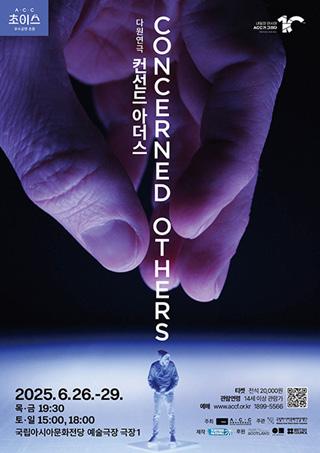
Dates: June 26–29 (Thur.–Sun.)
Times: Thur. & Fri. 7:30 p.m.; Sat. & Sun. 3:00 & 6:00 p.m.
Venue: Asia Culture Center, Arts Theater 1
Reservations: Asia Culture Center website
Admission: All seats 20,000 won
Age Restriction: 14 years of age or older
Ki Su Percussion Recital
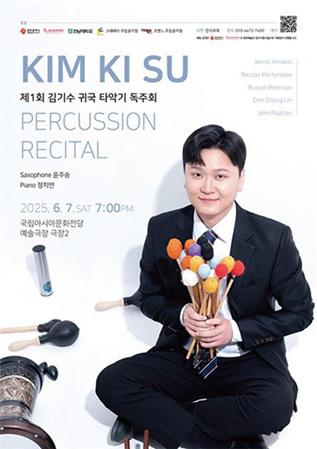
Date: June 7 (Sat.), 7:00 p.m.
Venue: Asia Culture Center, Arts Theater 2
Reservations: Asia Culture Center website
Admission: Free
Age Restriction: 5 years of age or older
Phone: 010-4472-7450
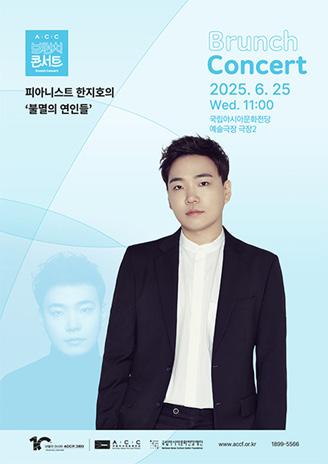
Phone: 1899-5566
Date: June 25 (Wed.), 11:00 a.m.
Venue: Asia Culture Center, Arts Theater 2
Reservations: Asia Culture Center website
Admission: R seats 30,000 won, S seats 20,000 won
Age Restriction: 7 years of age or older

Date: June 3 - July 28, 6:00 p.m. - 12:00 a.m.
Venue: Byeolbam Art Museum, 5 locations (Cheomdan, Suwan, Unnam, Shinchang, and Seonun)
Admission: Free
Age Restriction: No restriction
Phone: 062-960-3609
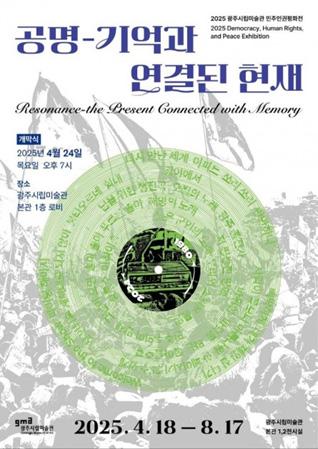
Dates: April 18 – August 24
Venue: Gwangju Museum of Art, Exhibition Rooms 1 & 2
Reservations: Free viewing
Admission: Free
Age Restriction: No restriction
Phone: 062-613-7100
• For more events and updates, you may visit the Oh My Gwangju website at https://dmgj.kr/
Compiled by Kim Jinyoung
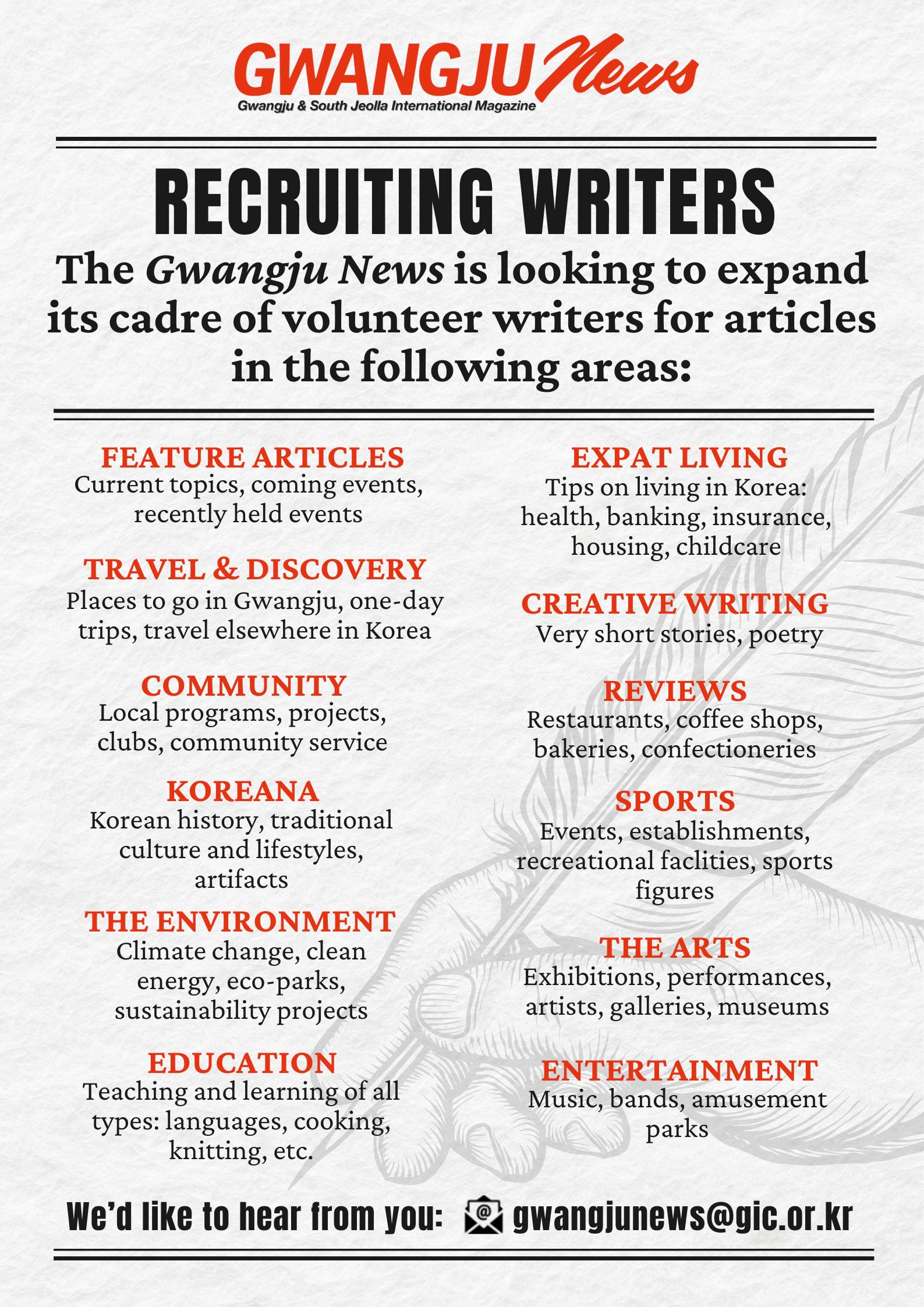
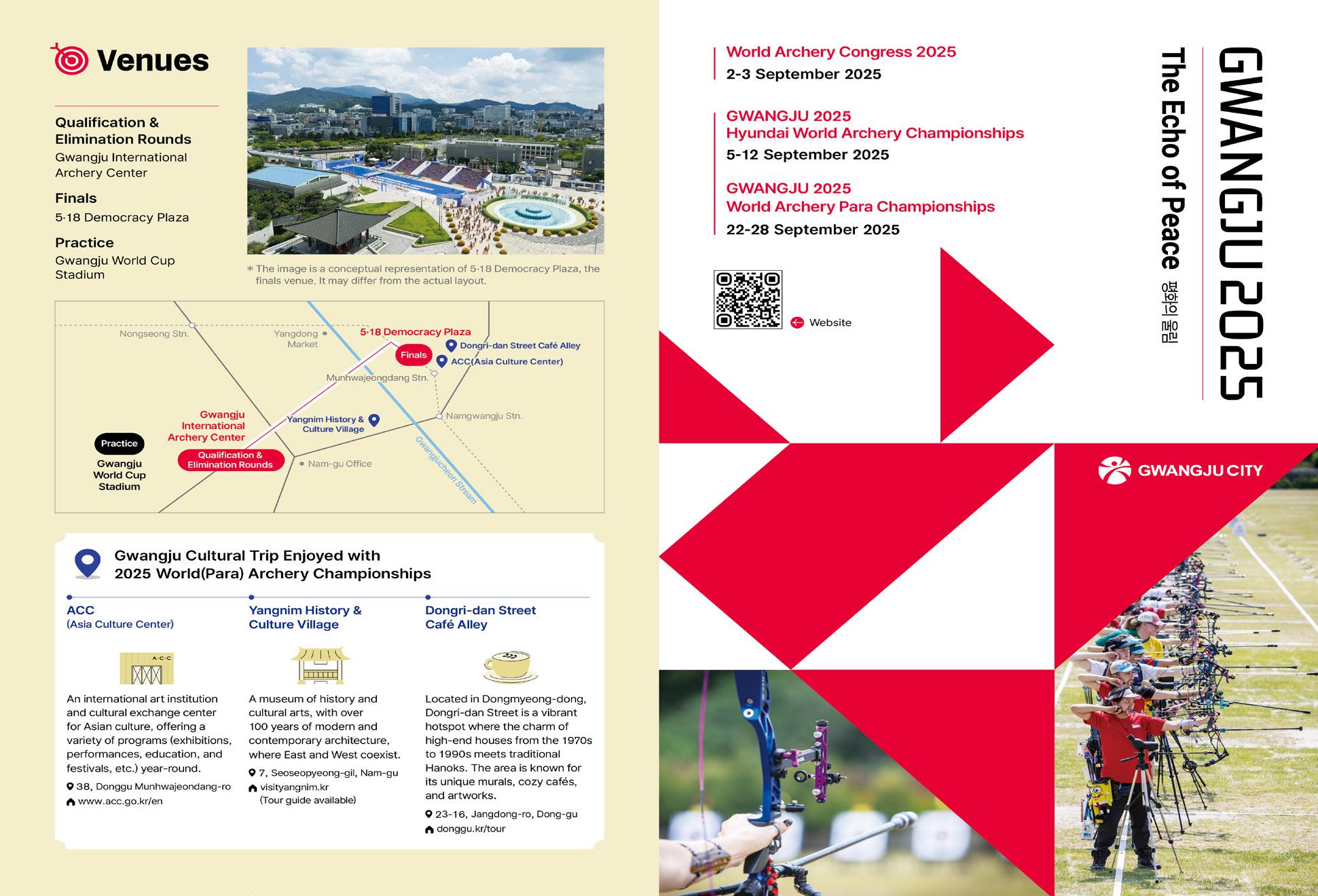
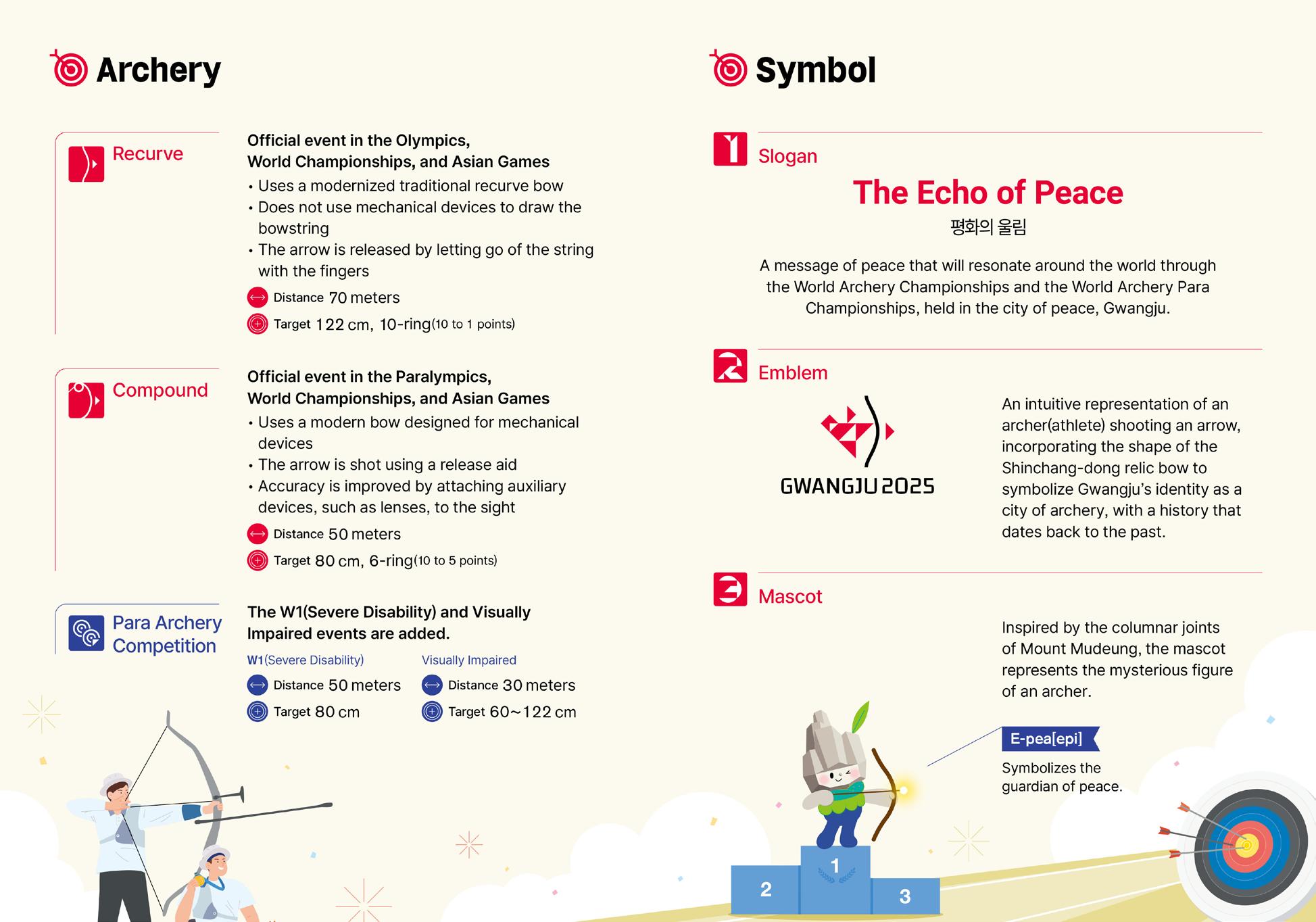
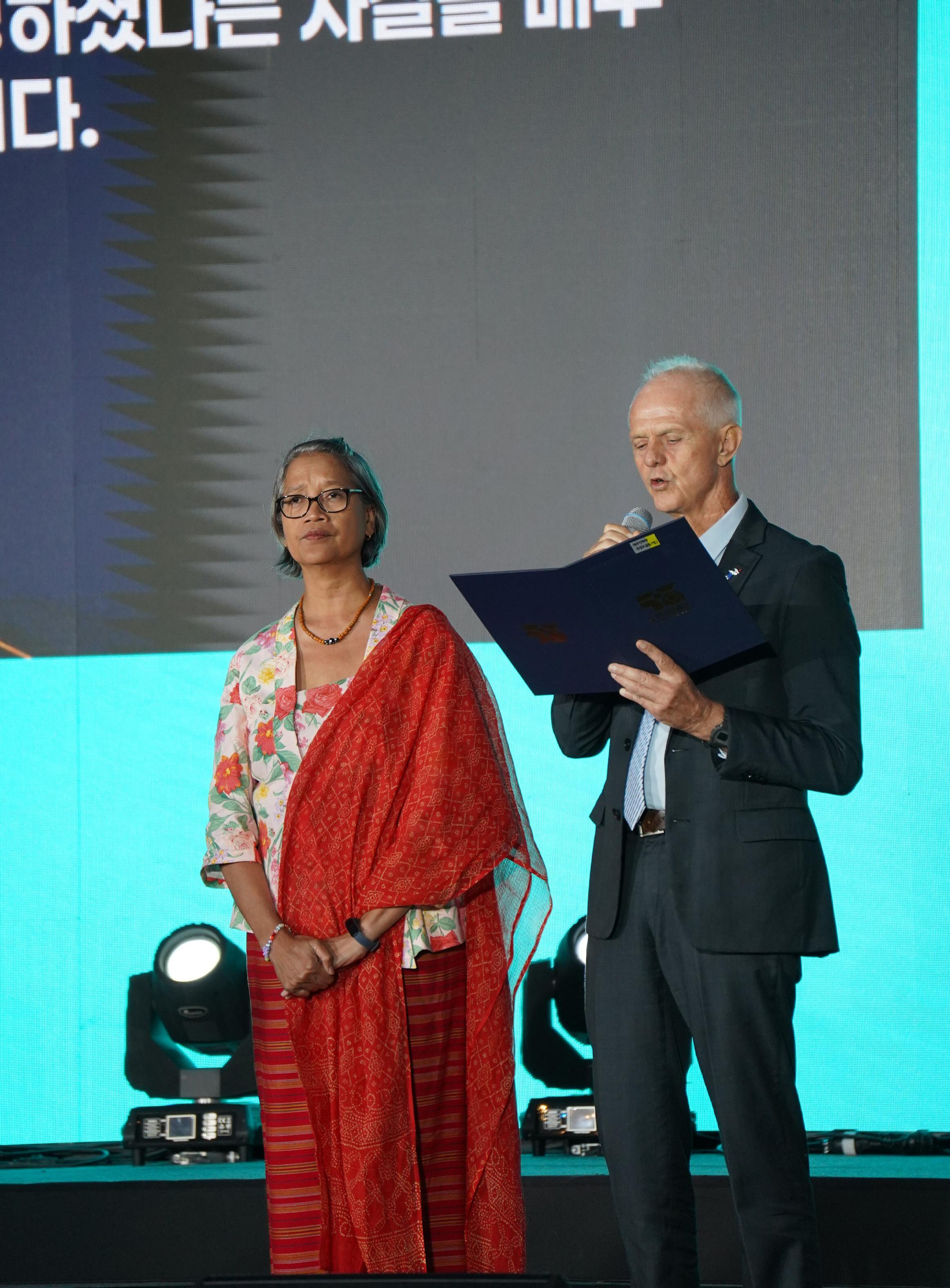
Asia Justice and Rights (AJAR) is awarded the Gwangju Prize for Human Rights. Receiving the award are AJAR co-founders Galuh Wandita (left) and Patrick Burgess.